#Aramaic Characters
Text
Amman Citadel and Temple of Hercules Ruins Amman Jordan
Umayyad Palace Mosque
Amman Citadel is an impressive open-air archaeological complex and a must-see for anyone visiting Amman. I didn’t realize that there were several significant landmarks at the site. It’s located on the highest hilltop in Amman – Jabal Al Qala’a – one of the seven hills (jabals) that originally made-up Amman.
Umayyad Palace Mosque Dome
Evidence suggests that the area has been…

View On WordPress
#6th Century Byzantine Church#Ain Ghazal Statues#Amman Citadel#Amman Jordan Seven Hills#Ancient City of Ammonites#Aramaic Characters#Babylonians#Bedouins#Bronze Age#Byzantines#Dead Sea Bronze Scroll#Jabal Al Qala&039;a#Jordan Archaeological Museum#Jordan Valley#Neolithic Period#Neolithic Statues#Persian-Style Apadana Hall#Ptolemies#Rabbath Ammon#Roman Emperor Marcus Aurelius#Roman Temple of Hercules#Roman Theater Amman#Romans#Seleucids#Temple of Hercules Ruins Amman Jordan#Umayyad Dynasty#Umayyad Mosque#Umayyad Palace#Umayyad Palace Domed Audience Hall#Umayyad Palace Mosque
0 notes
Text
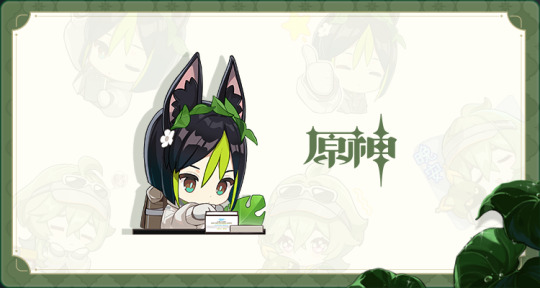












Genshin Impact CN x Kiehl's Collab Emote Pack (1/2)
#genshin impact#genshin collab#character artworks#emotes#Collab Emotes#PNGs#Tighnari#Aranara#Arama#Arakanta#Arabalika#Araphala#Aramani#can't find the name of the first Aranara sorry
349 notes
·
View notes
Text

My Genshin collection continues to grow
#maya’s crafts#pipe cleaner#pipe cleaner crafts#crafting#crafts#genshin impact#rex lapis#andrius#azhdaha#dvalin#wisp venti#yae miko#aranara#arama#Fontaine better have a cute mascot character so I can keep making these#Does Oceanid count as a Fontaine creature?
10 notes
·
View notes
Text
Arasomething...
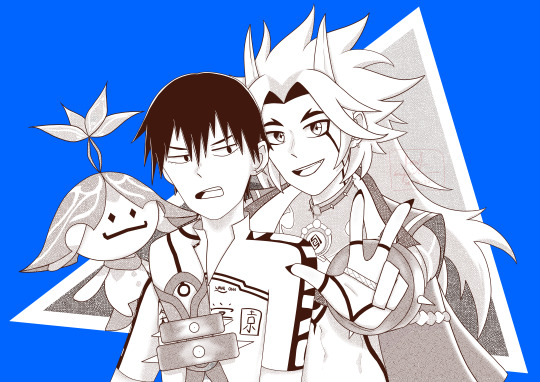
Aka the crossover that no one asked for lol. I initially drew this because after rewatching Yowamushi Pedal, I got Arataki Itto and Arakita Yasutomo mixed up because of how their names were spelt and Arama is just there to look cute, it's like the Kuzuha and Kazuha situation all over again!! XD
The other reason why I drew this is because I wanted to experiment the screen tones in Medibang since I hardly use them.
#my art#artists on tumblr#digital fanart#yowamushi pedal fanart#yowamushi pedal#yowamushi pedaru#genshin#genshin impact#genshin impact fanart#arakita yasutomo#arataki itto#arataki fanart#aranara#arama#a crossover that no one asked for XD#I feel like the screen tones at the back blend a bit too much to the screen tones on the characters but oh well#digitalart#digital art
6 notes
·
View notes
Text

Let's Talk About Magic Systems.
There are two broad ways you can establish magic in your story world - work with existing concepts, or adapting it for something new.
Pick a System
High Magic vs. Low Magic
This distinction existes mostly in the western wrld from the Middle Ages onwards. In non-western cultures, this distinct often doesn't exist.
High magic requires magicians to study from books, ingredients are expensive and instruments elaborate and hard to get. The typical practioner of High Magic is of the upper class, highly educated, and rich. They serve in King's courts and have high social standing thanks to their knowledge.
Among the lower classes and women, Low Magic is ore common. It is taught orally and doesn't require reading skills and uses everyday objects and ingredients.
Black vs. White Magic
"White" magic is often associated with good, and "Black" with the evil. However, what really matters is the magicians intension, not the magic system that they work with.
The term "black magic" is often associated with working with the dead. It can also be used by an individual/group who just wants to appear more menacing.
Ceremonial Magic
This kind of magic involves lots of ritual, recitation and prayer, often in ancient langauges such as Latin, Aramaic and Sanskrit.
Most of the time, it's High Magic and practiced by religious figures.
The typical practioner is educated, has great confidence and a good memory.
Natural Magic
It involves ingredients from nature, such as herbs and water.
It may be practiced outdoor, in a kitchen, or in a laboratory.
The rituals are simple and short, and the practioner will watch out for the turning of seasons, phases of the moon, etc.
Religious Magic
This is a diety working through a magician. The magician prays and asks her god to work the miracle.
Most religions have their own form of magic, and the kind of miracles that the magicians can bring can be limited.
Wiccan Witchcraft and Voodoo are largely religious magic.
The typical practioner would be spiritual and devout, often suspicious of other religions.
Alchemy
Alchemy is both High and Low Magic, and it can incorporate religious, spiritual, philosophical and mythological elements.
In a modern setting, alchemy can also be portrayed as "science gone too far".
The typical practioner would be patient, methodious, educated and driven. The tools includes laboratory equipment, astronomical charts, writing materials, and an unsuspecting roommate(?) for testing.
Traditional Witchcraft
Traditional Witchcraft is a form of Low Magic. In early historic periods, the witch played an important role in village life, often old women who owned apothecaries and helped out other villagers.
The typical practioner would be female, uneducated, illiterate, practical, resourceful and poor. She will have a good memory and well-developed senses.
Tools used would be simple household implements - a cauldron, a broom, knife, etc. that can evade the Inquisitor's suspicions.
Wiccan Witchcraft
If you write contemporary fiction, this is the system your character is most likely to use. It's modern witchcraft, based on the religion of Wicca.
Wiccan witchcraft mostly developed in the second half of the twentieth centruy. It is a form of bothe Natural Magic and Religious Magic.
Based on nature worship and the polarity between male and female, the magician often begins a Wiccan ritual with an invocation to a God/Godess. The Lady (Godess) is depicted as having three aspects: Maiden, Mother and Brone. The Lord (God) may be depicted with horns.
The focus of Wiccan magic is often on healing, with an emphasis of ethical consequences of what is being performed.
It is often practiced outdoors, sometimes naked (which they call 'skyclad'). Wiccan witchcraft uses the phases of the moon to amplify its effects.
Wiccan like to gather in groups called 'covens' or to meet once a month or for major festivals. The coven leader may be called 'high piestess/priest'.
Typical tools include a chalice, a knife (called 'athame'), a wand, candles, herbs, crystals, and essential oils.
Necromancy
The magician summons a dead person, either ghost or spirit, sometimes bodily. The dead are enlisted to grant the magicians with favors or are questioned for information.
It may be related to Shamanism, as well as to some forms of psychic work such as channelling and Spiritualist seances.
The typical practitioner is psychally gisted, strong-willed and courageous.
Shamnism
Shamnism is a Low Magic system. The shaman intercedes between the human and spirit world by communicating with spirits, often to obtain information or provide healing.
Shamans may travel to the spirit world to seek answered, with some level of danger. They use drums, chanting, dancing and drugs to alter their consciousness and communicate with spirits.
Practicing shamans often work alone, but they choose a successor to train. The apprentice is supposed to accept the calling.
The typical shaman is musical, sensitive with a strong sense of rhythm and the psychic.
Tools include drums, bells, a costume, herbs, bones, smoke and mind-altering drugs.
Ancient Egyptian Magic
Ancient Eyptian Magic ovelaps with Religious magic, medicine and with psychic work. The deities most frequently evoked are Selket, Aset for raising the dead, and the gof Thoth for anything to do with sickness and healing.
The emphasis of Ancient Egyptian Magic is protection, often done throgugh an amulet or talisman. The circle or oval is the most important shape that has protective qualities.
The precise wording of a spell is important, as well as the colors that are involved. For magic to affect someone the magicians must know that person's true name.
The typical practitioner is male, literate, often a priest attached to a emple.
Folk Magic
This is a form of Low Magic practiced by amateurs.
This includes housekeepers who can keep the rats out, farmers who can ripen fruit before the height of the season, and scullions who can make water boil faster.
This people would only know a handful of spells, ans pass them in to memebers of their family.
Voodoo
Voodoo is religious magic and low magic.
The rituals are held in private, and may involve communication with spirits, especially the spirits of ancestors and saints.
Commonly used to cure aliments, confound enemies, and obtain desires.
Invent a System
Choosing the Right Words
If your character is clearly a witch, shaman, a necromancer, etc. with a specialty, use that term. Otherwise, the word "magician", or "mage" would be most appropriate.
The term "magus" (plural magi) refers to practitioners of the ancient Zoroastrian faith.
Strictly speaking, witches and wizards are practitioners of two very different magic systems, so your female character can be a wizard, and vice versa.
'Warlock' really means 'oath-breaker' or 'traitor' and doesn't describe a magician.
'Conjurer' is someone who can creae effects to impress an audience, not really magical in itself. The more modern temr would be 'illusionist'
A group of magicians may be called a 'coven' (though it applies mostly to Wiccan magic). A magician working alone would be a 'solitary'.
Magic vs. Magick
Normally, "magic" is the correct spelling.
However, "magick" may be used, especially by insiders, to emphasize that they refer to the real thing, not conjuring or other trick of the eye.
The magic systems are sometimes capitalized, sometimes not. When it involves a religion, nationaliy, or a particular family line, it is capitalized. Just make sure to keep it consistent throughout your book.
If you like my blog, buy me a coffee☕ and find me on instagram! 📸
#writer#writers#creative writing#writing#writing community#writers of tumblr#creative writers#writing inspiration#writeblr#writing tips#writers corner#writers community#poets and writers#writing advice#writing resources#writers on tumblr#writers and poets#helping writers#writing help#writing tips and tricks#how to write#writing life#let's write#resources for writers#references for writers
219 notes
·
View notes
Text
The most important deity you've never heard of: the 3000 years long history of Nanaya
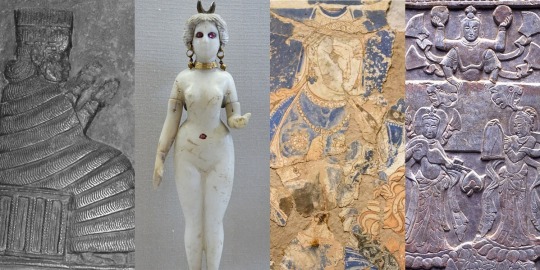
Being a major deity is not necessarily a guarantee of being remembered. Nanaya survived for longer than any other Mesopotamian deity, spread further away from her original home than any of her peers, and even briefly competed with both Buddha and Jesus for relevance. At the same time, even in scholarship she is often treated as unworthy of study. She has no popculture presence save for an atrocious, ill-informed SCP story which can’t get the most basic details right. Her claims to fame include starring in fairly explicit love poetry and appearing where nobody would expect her. Therefore, she is the ideal topic to discuss on this blog.
This is actually the longest article I published here, the culmination of over two years of research. By now, the overwhelming majority of Nanaya-related articles on wikipedia are my work, and what you can find under the cut is essentially a synthesis of what I have learned while getting there. I hope you will enjoy reading it as much as I enjoyed working on it.
Under the cut, you will learn everything there is to know about Nanaya: her origin, character, connections with other Mesopotamian deities, her role in literature, her cult centers… Since her history does not end with cuneiform, naturally the later text corpora - Aramaic, Bactrian, Sogdian and even Chinese - are discussed too. The article concludes with a short explanation why I see the study of Nanaya as crucial.
Dubious origins and scribal wordplays: from na-na to Nanaya
Long ago Samuel Noah Kramer said that “history begins in Sumer”. While the core sentiment was not wrong in many regards, in this case it might actually begin in Akkad, specifically in Gasur, close to modern Kirkuk. The oldest possible attestation of Nanaya are personal names from this city with the element na-na, dated roughly to the reign of Naram-Sin of Akkad, so to around 2250 BCE. It’s not marked in the way names of deities in personal names would usually be, but this would not be an isolated case.
The evidence is ultimately mixed. On one hand, reduplicated names like Nana are not unusual in early Akkadian sources, and -ya can plausibly be explained as a hypocoristic suffix. On the other hand, there is not much evidence for Nanaya being worshiped specifically in the far northeast of Mesopotamia in other periods. Yet another issue is that there is seemingly no root nan- in Akkadian, at least in any attested words.
The main competing proposal is that Nanaya originally arose as a hypostasis of Inanna but eventually split off through metaphorical mitosis, like a few other goddesses did, for example Annunitum. This is not entirely implausible either, but ultimately direct evidence is lacking, and when Nanaya pops up for the first time in history she is clearly a distinct goddess.
There are a few other proposals regarding Nanaya’s origin, but they are considerably weaker. Elamite has the promising term nan, “day” or “morning”, but Nanaya is entirely absent from the Old Elamite sources you’d expect to find her in if Mesopotamians imported her from the east. Therefore, very few authors adhere to this view. The hypothesis that she was an Aramaic goddess in origin does not really work chronologically, since Aramaic is not attested in the third millennium BCE at all. The less said about attempts to connect her to anything “Proto-Indo-European”, the better.
Like many other names of deities, Nanaya’s was already a subject of etymological speculation in antiquity. A late annotated version of the Weidner god list, tablet BM 62741, preserves a scribe’s speculative attempt at deriving it from the basic meaning of the sign NA, “to call”, furnished with a feminine suffix, A. Needless to say, like other such examples of scribal speculation, some of which are closer to playful word play than linguistics, it is unlikely to reflect the actual origin of the name.
Early history: Shulgi-simti, Nanaya’s earliest recorded #1 fan
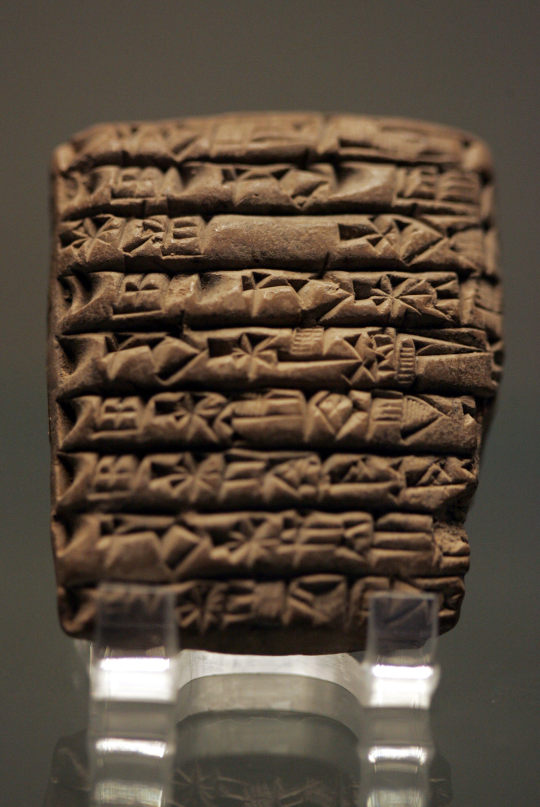
A typical Ur III administrative tablet listing offerings to various deities (wikimedia commons)
The first absolutely certain attestations of Nanaya, now firmly under her full name, have been identified in texts from the famous archive from Puzrish-Dagan, modern Drehem, dated to around 2100 BCE. Much can be written about this site, but here it will suffice to say that it was a center of the royal administration of the Third Dynasty of Ur ("Ur III") responsible for the distribution of sacrificial animals.
Nanaya appears there in a rather unique context - she was one of the deities whose cults were patronized by queen Shulgi-simti, one of the wives of Shulgi, the successor of the dynasty’s founder Ur-Namma.
We do not know much about Shulgi-simti as a person - she did not write any official inscriptions announcing her preferred foreign policy or letters to relatives or poetry or anything else that typically can be used to gain a glimpse into the personal lives of Mesopotamian royalty. We’re not really sure where she came from, though Eshnunna is often suggested as her hometown. We actually do not even know what her original name was, as it is assumed she only came to be known as Shulgi-simti after becoming a member of the royal family. Tonia Sharlach suggested that the absence of information about her personal life might indicate that she was a commoner, and that her marriage to Shulgi was not politically motivated
The one sphere of Shulgi-simti’s life which we are incredibly familiar with are her religious ventures. She evidently had an eye for minor, foreign or otherwise unusual goddesses, such as Belet-Terraban or Nanaya.
She apparently ran what Sharlach in her “biography” of her has characterized as a foundation. It was tasked with sponsoring various religious celebrations. Since Shulgi-simti seemingly had no estate to speak of, most of the relevant documents indicate she procured offerings from a variety of unexpected sources, including courtiers and other members of the royal family. The scale of her operations was tiny: while the more official religious organizations dealt with hundreds or thousands of sacrificial animals, up to fifty or even seventy thousand sheep and goats in the case of royal administration, the highest recorded number at her disposal seems to be eight oxen and fifty nine sheep.
A further peculiarity of the “foundation” is that apparently there was a huge turnover rate among the officials tasked with maintaining it. It seems nobody really lasted there for much more than four years. There are two possible explanations: either Shulgi-simti was unusually difficult to work with, or the position was not considered particularly prestigious and was, at the absolute best, viewed as a stepping stone.
While the Shulgi-simti texts are the earliest evidence for worship of Nanaya in the Ur III court, they are actually not isolated. When all the evidence from the reigns of Shulgi and his successors is summarized, it turns out that she quickly attained a prominent role, as she is among the twelve deities who received the most offerings. However, her worship was seemingly limited to Uruk (in her own sanctuary), Nippur (in the temple of Enlil, Ekur) and Ur. Granted, these were coincidentally three of the most important cities in the entire empire, so that’s a pretty solid early section of a divine resume. She chiefly appears in two types of ceremonies: these tied to the royal court, or these mostly performed by or for women. Notably, a festival involving lamentations (girrānum) was held in her honor in Uruk.
To understand Nanaya’s presence in the two aforementioned contexts, and by extension her persistence in Mesopotamian religion in later periods, we need to first look into her character.
The character of Nanaya: eroticism, kingship, and disputed astral ventures

Corona Borealis (wikimedia commons)
Nanaya’s character is reasonably well defined in primary sources, but surprisingly she was almost entirely ignored in scholarship quite recently. The first study of her which holds up to scrutiny is probably Joan Goodnick Westenholz’s article Nanaya, Lady of Mystery from 1997. The core issue is the alleged interchangeability of goddesses. From the early days of Assyriology basically up to the 1980s, Nanaya was held to be basically fully interchangeable with Inanna. This obviously put her in a tough spot. Still, over the course of the past three decades the overwhelming majority of studies came to recognize Nanaya as a distinct goddess worthy of study in her own right. You will still stumble upon the occasional “Nanaya is basically Inanna”, but now this is a minority position. Tragically it’s not extinct yet, most recently I’ve seen it in a monograph published earlier this year.
With these methodological and ideological issues out of the way, let’s actually look into Nanaya’s character, as promised by the title of this section. Her original role was that of a goddess of love. It is already attested for her at the dawn of her history, in the Ur III period. Her primary quality was described with a term rendered as ḫili in Sumerian and kuzbu in Akkadian. It can be variously translated as “charm”, “luxuriance”, “voluptuousness”, “sensuality” or “sexual attractiveness”. This characteristic was highlighted by her epithet bēlet kuzbi (“lady of kuzbu”) and by the name of her cella in the Eanna, Eḫilianna. The connection was so strong that this term appears basically in every single royal inscription praising her. She was also called bēlet râmi, “lady of love”. Nanaya’s role as a love goddess is often paired with describing her as a “joyful” or “charming” deity.
It needs to be stressed that Nanaya was by no metric the goddess of some abstract, cosmic love or anything like that. Love incantations and prayers related to love are quite common, and give us a solid glimpse into this matter. Nanaya’s range of activity in them is defined pretty directly: she deals with relationships (and by extension also with matters like one-sided crushes or arguments between spouses), romance and with strictly sexual matters. For an example of a hymn highlighting her qualifications when it comes to the last category, see here. The text is explicit, obviously.
We can go deeper, though. There is also an incantation whose incipit at first glance leaves little to imagination:

However, the translator, Giole Zisa, notes there is some debate over whether it’s actually about having sex with Nanaya or merely about invoking her (and other deities) while having sex with someone else. A distinct third possibility is that she’s not even properly invoked but that “oh, Nanaya” is simply an exclamation of excitement meant to fit the atmosphere, like a specialized version of the mainstay of modern erotica dialogue, “oh god”.
While this romantic and sexual aspect of Nanaya’s character is obviously impossible to overlook, this is not all there was to her. She was also associated with kingship, as already documented in the Ur III period. She was invoked during coronations and mourning of deceased kings. In the Old Babylonian period she was linked to investiture by rulers of newly independent Uruk.
A topic which has stirred some controversy in scholarship is Nanaya’s supposed astral role. Modern authors who try to present Nanaya as a Venus deity fall back on rather faulty reasoning, namely asserting that if Nanaya was associated with Inanna and Inanna personified Venus, clearly Nanaya did too. Of course, being associated with Inanna does not guarantee the same traits. Shaushka was associated with her so closely her name was written with the logogram representing her counterpart quite often, and lacked astral aspects altogether.
No primary sources which discuss Nanaya as a distinct, actively worshiped deity actually link her with Venus. If you stretch it you will find some tidbits like an entry in a dictionary prepared by the 10th century bishop Hasan bar Bahlul, who inexplicably asserted Nanaya was the Arabic name of the planet Venus. As you will see soon, there isn’t even a possibility that this reflected a relic of interpretatio graeca. The early Mandaean sources, many of which were written when at least remnants of ancient Mesopotamian religion were still extant, also do not link Nanaya with Venus. Despite at best ambivalent attitude towards Mesopotamian deities, they show remarkable attention to detail when it comes to listing their cult centers, and on top of that Mesopotamian astronomy had a considerable impact on Mandaeism, so there is no reason not to prioritize them, as far as I am concerned.
As far as the ancient Mesopotamian sources themselves go, the only astral object with a direct connection to Nanaya was Corona Borealis (BAL.TÉŠ.A, “Dignity”), as attested in the astronomical compendium MUL.APIN. Note that this is a work which assigns astral counterparts to virtually any deity possible, though, and there is no indication this was a major part of Nanaya’s character. Save for this single instance, she is entirely absent from astronomical texts.
A further astral possibility is that Nanaya was associated with the moon. The earliest evidence is highly ambiguous: in the Ur III period festivals held in her honor might have been tied to phases of the moon, while in the Old Babylonian period a sanctuary dedicated to her located in Larsa was known under the ceremonial name Eitida, “house of the month”. A poem in which looking at her is compared to looking at the moon is also known. That’s not all, though. Starting with the Old Babylonian period, she could also be compared with the sun. Possibly such comparisons were meant to present her as an astral deity, without necessarily identifying her with a specific astral body. Michael P. Streck and Nathan Wasserman suggest that it might be optimal to simply refer to her as a “luminous” deity in this context. However, as you will see later it nonetheless does seem she eventually came to be firmly associated both with the sun and the moon.
Last but not least, Nanaya occasionally displayed warlike traits. It’s hardly major in her case, and if you tried hard enough you could turn any deity into a war deity depending on your political goals, though. I’d also place the incantation which casts her as one of the deities responsible for keeping the demon Lamashtu at bay here.
Nanaya in art
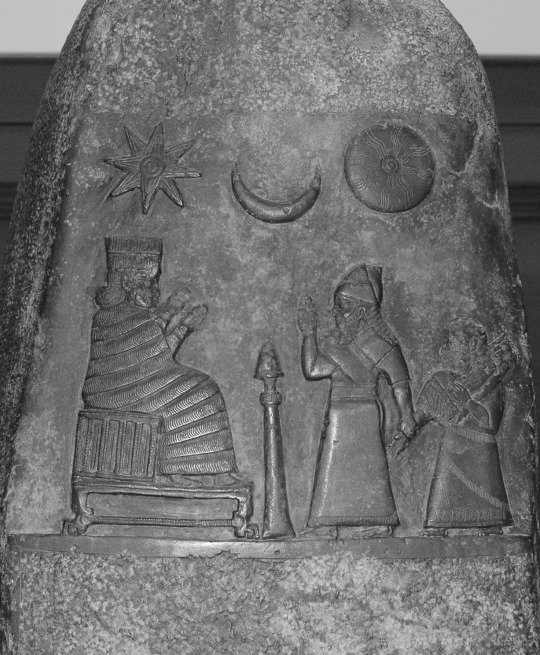
The oldest known depiction of Nanaya (wikimedia commons)
While Nanaya’s roles are pretty well defined, there surprisingly isn’t much to say about her iconography in Mesopotamian art.The oldest certain surviving depiction of her is rather indistinct: she’s wearing a tall headdress and a flounced robe. It dates to the late Kassite period (so roughly to 1200 BCE), and shows her alongside king Meli-Shipak (or maybe Meli-Shihu, reading remains uncertain) and his daughter Hunnubat-Nanaya. Nanaya is apparently invoked to guarantee that the prebend granted to the princess will be under divine protection. This is not really some unique prerogative of hers, perhaps she was just the most appropriate choice because Hunnubat-Nanaya’s name obviously reflects devotion to her.
The relief discussed above is actually the only depiction of Nanaya identified with certainty from before the Hellenistic period, surprisingly. We know that statues representing her existed, and it is hard to imagine that a popular, commonly worshiped deity was not depicted on objects like terracotta decorations and cylinder seals, but even if some of these were discovered, there’s no way to identify them with certainty. This is not unusual though, and ultimately there aren’t many Mesopotamian deities who can be identified in art without any ambiguity.
Nanaya in literature
As I highlighted in the section dealing with Nanaya’s character, she is reasonably well attested in love poetry. However, this is not the only genre in which she played a role.
A true testament to Nanaya’s prominence is a bilingual (Sumero-Akkadian) hymn composed in her honor in the first millennium BCE. It is written in the first person, and presents various other goddesses as her alternate identities. It is hardly unique, and similar compositions dedicated to Ishtar (Inanna), Gula, Ninurta and Marduk are also known.
Each strophe describes a different deity and location, but ends with Nanaya reasserting her actual identity with the words “still I am Nanaya”. Among the claimed identities included are both major goddesses in their own right (Inanna plus closely associated Annunitum and Ishara, Gula, Bau, Ninlil), goddesses relevant due to their spousal roles first and foremost (Damkina, Shala, Mammitum etc) and some truly unexpected, picks, the notoriously elusive personified rainbow Manzat being the prime example. Most of them had very little in common with Nanaya, so this might be less an attempt at syncretism, and more an elevation of her position through comparisons to those of other goddesses.
An additional possible literary curiosity is a poorly preserved myth which Wilfred G. Lambert referred to as “The murder of Anshar”. He argues that Nanaya is one of the two deities responsible for the eponymous act. I don't quite follow the logic, though: the goddess is actually named Ninamakalamma (“Lady mother of the land”), and her sole connection with Nanaya is that they occur in sequence in the unique god list from Sultantepe. Lambert saw this as a possible indication they are identical. There are no other attestations of this name, but ama kalamma does occur as an epithet of various goddesses, most notably Ninshubur. Given her juxtaposition with Nanaya in the Weidner god list - more on that later - wouldn’t it make more sense to assume it’s her? Due to obscurity of the text as far as I am aware nobody has questioned Lambert’s tentative proposal yet, though.
There isn’t much to say about the plot: Anshar, literally “whole heaven”, the father of Anu, presumably gets overthrown and might be subsequently killed. Something that needs to be stressed here to avoid misinterpretation: primordial deities such as Anshar were borderline irrelevant, and weren't really worshiped. They exist to fade away in myths and to be speculated about in elaborate lexical texts. There was no deposed cult of Anshar. Same goes for all the Tiamats and Enmesharras and so on.
Inanna and beyond: Nanaya and friends in Mesopotamian sources
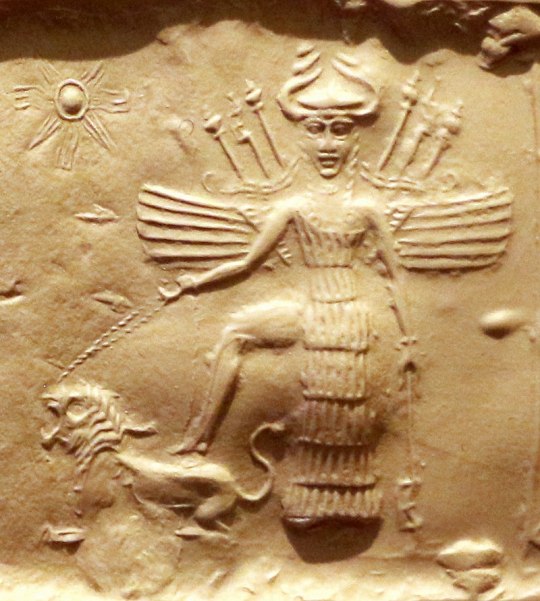
Inanna on a cylinder seal from the second half of the third millennium BCE (wikimedia commons)
Of course, Nanaya’s single most important connection was that to Inanna, no matter if we are to accept the view that she was effectively a hypostasis gone rogue or not. The relationship between them could be represented in many different ways. Quite commonly she was understood as a courtier or protegee of Inanna. A hymn from the reign of Ishbi-Erra calls her the “ornament of Eanna” (Inanna’s main temple in Uruk) and states she was appointed by Inanna to her position. References to Inanna as Nanaya’s mother are also known, though they are rare, and might be metaphorical. To my best knowledge nothing changed since Olga Drewnowska-Rymarz’s monograph, in which she notes she only found three examples of texts preserving this tradition. I would personally abstain from trying to read too deep into it, given this scarcity.
Other traditions regarding Nanaya’s parentage are better attested. In multiple cases, she “borrows” Inanna’s conventional genealogy, and as a result is addressed as a daughter of Sin (Nanna), the moon god. However, she was never addressed as Inanna’s sister: it seems that in cases where Sin and Nanaya are connected, she effectively “usurps” Inanna’s own status as his daughter (and as the sister of Shamash, while at it). Alternatively, she could be viewed as a daughter of Anu.
Finally, there is a peculiar tradition which was the default in laments: in this case, Nanaya was described as a daughter of Urash. The name in this context does not refer to the wife of Anu, though. The deity meant is instead a small time farmer god from Dilbat. To my best knowledge no sources place Nanaya in the proximity of other members of Urash’s family, though some do specify she was his firstborn daughter. To my best knowledge Urash had at least two other children, Lagamal (“no mercy”, an underworld deity whose gender is a matter of debate) and Ipte-bitam (“he opened the house”, as you can probably guess a divine doorkeeper). Nanaya’s mother by extension would presumably be Urash’s wife Ninegal, the tutelary goddess of royal palaces. There is actually a ritual text listing these three together.
In the Weidner god list Nanaya appears after Ninshubur. Sadly, I found no evidence for a direct association between these two. For what it’s worth, they did share a highly specific role, that of a deity responsible for ordering around lamma. This term referred to a class of minor deities who can be understood as analogous to “guardian angels” in contemporary Christianity, except places and even deities had their own lamma too, not just people. Lamma can also be understood at once as a class of distinct minor deities, as the given name of individual members of it, and as a title of major deities. In an inscription of Gudea the main members of the official pantheon are addressed as “lamma of all nations”, by far one of my favorite collective terms of deities in Mesopotamian literature.
A second important aspect of the Weidner god list is placing Nanaya right in front of Bizilla. The two also appear side by side in some offering lists and in the astronomical compendium MUL.APIN, where they are curiously listed as members of the court of Enlil. It seems that like Nanaya, she was a goddess of love, which is presumably reflected by her name. It has been variously translated as “pleasing”, “loving” or as a derivative of the verb “to strip”. An argument can be made that Bizilla was to Nanaya what Nanaya was to Inanna. However, she also had a few roles of her own. Most notably, she was regarded as the sukkal of Ninlil. She may or may not also have had some sort of connection to Nungal, the goddess of prisons, though it remains a matter of debate if it’s really her or yet another, accidentally similarly named, goddess.

An indistinct Hurro-Hittite depiction of Ishara from the Yazilikaya sanctuary (wikimedia commons)
In love incantations, Nanaya belonged to an informal group which also included Inanna, Ishara, Kanisurra and Gazbaba. I do not think Inanna’s presence needs to be explained. Ishara had an independent connection with Inanna and was a multi-purpose deity to put it very lightly; in the realm of love she was particularly strongly connected with weddings and wedding nights. Kanisurra and Gazbaba warrant a bit more discussion, because they are arguably Nanaya’s supporting cast first and foremost.
Gazbaba is, at the core, seemingly simply the personification of kuzbu. Her name had pretty inconsistent orthography, and variants such as Kazba or Gazbaya can be found in primary sources too. The last of them pretty clearly reflects an attempt at making her name resemble Nanaya’s. Not much can be said about her individual character beyond the fact she was doubtlessly related to love and/or sex. She is described as the “grinning one” in an incantation which might be a sexual allusion too, seeing as such expressions are a mainstay of Akkadian erotic poetry.
Kanisurra would probably win the award for the fakest sounding Mesopotamian goddess, if such a competition existed. Her name most likely originated as a designation of the gate of the underworld, ganzer. Her default epithet was “lady of the witches” (bēlet kaššāpāti). And on top of that, like Nanaya and Gazbaba she was associated with sex. She certainly sounds more like a contemporary edgy oc of the Enoby Dimentia Raven Way variety than a bronze age goddess - and yet, she is completely genuine.
It is commonly argued Kanisurra and Gazbaba were regarded as Nanaya’s daughters, but there is actually no direct evidence for this. In the only text where their relation to Nanaya is clearly defined they are described as her hairdressers, rather than children.
While in some cases the love goddesses appear in love incantations in company of each other almost as if they were some sort of disastrous polycule, occasionally Nanaya is accompanied in them by an anonymous spouse. Together they occur in parallel with Inanna and Dumuzi and Ishara and Almanu, apparently a (accidental?) deification of a term referring to someone without family obligations.
There is only one Old Babylonian source which actually assigns a specific identity to Nanaya’s spouse, a hymn dedicated to king Abi-eshuh of Babylon. An otherwise largely unknown god Muati (I patched up his wiki article just for the sake of this blog post) plays this role here.
The text presents a curious case of reversal of gender roles: Muati is asked to intercede with Nanaya on behalf of petitioners. Usually this was the role of the wife - the best known case is Aya, the wife of Shamash, who is implored to do just that by Ninsun in the standard edition of the Epic of Gilgamesh. It’s also attested for goddesses such as Laz, Shala, Ninegal or Ninmug… and in the case of Inanna, for Ninshubur.

A Neo-Assyrian statue of Nabu on display in the Iraq Museum (wikimedia commons)
Marten Stol seems to treat Muati and Nabu as virtually the same deity, and on this basis states that Nanaya was already associated with the latter in the Old Babylonian period, but this seems to be a minority position. Other authors pretty consistently assume that Muati was a distinct deity at some point “absorbed” by Nabu.
The oldest example of pairing Nanaya with Nabu I am aware of is an inscription dated to the reign of Marduk-apla-iddina I, so roughly to the first half of the twelfth century BCE. The rise of this tradition in the first millennium BCE was less theological and more political. With Babylon once again emerging as a preeminent power, local theologies were supposed to be subordinated to the one followed in the dominant city. Which, at the time, was focused on Nabu, Marduk and Zarpanit. Worth noting that Nabu also had a spouse before, Tashmetum (“reconciliation”). In the long run she was more or less ousted by Nanaya from some locations, though she retained popularity in the north, in Assyria. She is not exactly the most thrilling deity to discuss. I will confess I do not find the developments tied to Nanaya and Nabu to be particularly interesting to cover, but in the long run they might have resulted in Nanaya acquiring probably the single most interesting “supporting cast member” she did not share with Inanna, so we’ll come back to this later.
Save for Bizilla, Nanaya generally was not provided with “equivalents” in god lists. I am only aware of one exception, and it’s a very recent discovery. Last year the first ever Akkadian-Amorite bilingual lists were published. This is obviously a breakthrough discovery, as before Amorite was largely known just from personal names despite being a vernacular language over much of the region in the bronze age, but only one line is ultimately of note here. In a section of one of the lists dealing with deities, Nanaya’s Amorite counterpart is said to be Pidray. This goddess is otherwise almost exclusively known from Ugarit. This of course fits very well with the new evidence: recent research generally stresses that Ugarit was quintessentially an Amorite city (the ruling house even claimed descent from mythical Ditanu, who is best known from the grandiose fictional genealogies of Shamshi-Adad I and the First Dynasty of Babylon).
Sadly, we do not know how the inhabitants of Ugarit viewed Nanaya. A trilingual version of the Weidner list, with the original version furnished with columns listing Ugaritic and Hurrian counterparts of each deity, was in circulation, but the available copies are too heavily damaged to restore it fully. And to make things worse, much of it seems to boil down to scribal wordplay and there is no guarantee all of the correspondences are motivated theologically. For instance, the minor Mesopotamian goddess Imzuanna is presented as the counterpart of Ugaritic weather god Baal because her name contains a sign used as a shortened logographic writing of the latter. An even funnier case is the awkward attempt at making it clear the Ugaritic sun deity Shapash, who was female, is not a lesbian… by making Aya male. Just astonishing, really.
The worship of Nanaya
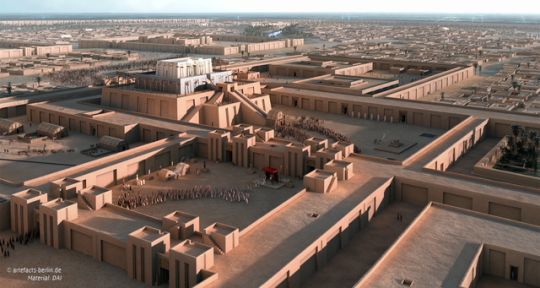
A speculative reconstruction of Ur III Uruk with the Eanna temple visible in the center (Artefacts — Scientific Illustration & Archaeological Reconstruction; reproduced here for educational purposes only, as permitted)
Rather fittingly, as a deity associated with Inanna, Nanaya was worshiped chiefly in Uruk. She is also reasonably well attested in the inscriptions of the short-lived local dynasty which regained independence near the end of the period of domination of Larsa over Lower Mesopotamia. A priest named after her, a certain Iddin-Nanaya, for a time served as the administrator of her temple, the Enmeurur, “house which gathers all the me,” me being a difficult to translate term, something like “divine powers”. The acquisition of new me is a common topic in Mesopotamian literature, and in compositions focused on Inanna in particular, so it should not be surprising to anyone that her peculiar double seemingly had similar interests.
In addition to Uruk, as well as Nippur and Ur, after the Ur III period Nanaya spread to multiple other cities, including Isin, Mari, Babylon and Kish. However, she is probably by far the best attested in Larsa, where she rose to the rank of one of the main deities, next to Utu, Inanna, Ishkur and Nergal. She had her own temple, the Eshahulla, “house of a happy heart”. In local tradition Inanna got to keep her role as an “universal” major goddess and her military prerogatives, but Nanaya overtook the role of a goddess of love almost fully. Inanna’s astral aspect was also locally downplayed, since Venus was instead represented in the local pantheon by closely associated, but firmly distinct, Ninsianna. This deity warrants some more discussion in the future just due to having a solid claim to being one of the first genderfluid literary figures in history, but due to space constraints this cannot be covered in detail here.
A later inscription from the same city differentiates between Nanaya and Inanna by giving them different epithets: Nanaya is the “queen of Uruk and Eanna” (effectively usurping Nanaya’s role) while Inanna is the “queen of Nippur” (that’s actually a well documented hypostasis of her, not to be confused with the unrelated “lady of Nippur”).
Uruk was temporarily abandoned in the late Old Babylonian period, but that did not end Nanaya’s career. Like Inanna, she came to be temporarily relocated to Kish. It has been suggested that a reference to her residence in “Kiššina” in a Hurro-Hittite literary text, the Tale of Appu, reflects her temporary stay there.
The next centuries of Nanaya are difficult to reconstruct due to scarce evidence, but it is clear she continued to be worshiped in Uruk. By the Neo-Babylonian period she was recognized as a member of an informal pentad of the main deities of the city, next to Inanna, Urkayitu, Usur-amassu and Beltu-sa-Resh. Two of them warrant no further discussion: Urkayitu was most likely a personification of the city, and Beltu-sa-Resh despite her position is still a mystery to researchers.
Usur-amassu, on the contrary, is herself a fascinating topic. First attestations of this deity, who was seemingly associated with law and justice (a pretty standard concern), come back to the Old Babylonian period. At this point, Usur-amassu was clearly male, which is reflected by the name. He appears in the god list An = Anum as a son of the weather deity couple par excellence, Adad (Ishkur) and Shala. However, by the early first millennium BCE Usur-amassu instead came to be regarded as female - without losing the connection to her parents. She did however gain a connection to Inanna, Nanaya and Kanisurra, which she lacked earlier. How come remains unknown. Most curiously her name was not modified to reflect her new gender, though she could be provided with a determinative indicating it. This recalls the case of Lagamal in the kingdom of Mari some 800 years earlier.
The end of the beginning: Nanaya under Achaemenids and Seleucids
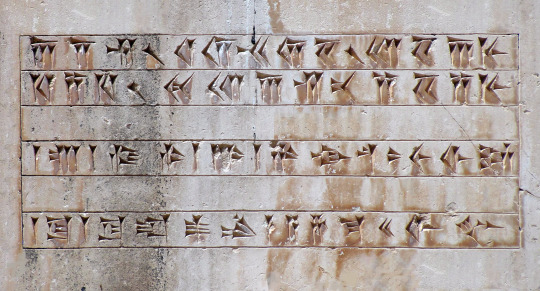
Trilingual (Persian, Elamite and Akkadian) inscription of the first Achamenid ruler of Mesopotamia, Cyrus (wikimedia commons)
After the fall of the Neo-Babylonian Empire Mesopotamia ended up under Achaemenid control, which in turn was replaced by the Seleucids. Nanaya flourished through both of these periods. In particular, she attained considerable popularity among Arameans. While they almost definitely first encountered her in Uruk, she quickly came to be venerated by them in many distant locations, like Palmyra, Hatra and Dura Europos in Syria. She even appears in a single Achaemenid Aramaic papyrus discovered in Elephantine in Egypt. It indicates that she was worshiped there by a community which originated in Rash, an area east to the Tigris. As a curiosity it’s worth mentioning the same source is one of the only attestations of Pidray from outside Ugarit. I do not think this has anything to do with the recently discovered connection between her and Nanaya… but you may never know.
Under the Seleucids, Nanaya went through a particularly puzzling process of partial syncretism. Through interpretatio graeca she was identified with… Artemis. How did this work? The key to understanding this is the fact Seleucids actually had a somewhat limited interest in local deities. All that was necessary was to find relatively major members of the local pantheon who could roughly correspond to the tutelary deities of their dynasty: Zeus, Apollo and Artemis. Zeus found an obvious counterpart in Marduk (even though Marduk was hardly a weather god). Since Nabu was Marduk’s son, he got to be Apollo. And since Nanaya was the most major goddess connected to Nabu, she got to be Artemis. It really doesn’t go deeper than that.
For what it’s worth, despite the clear difference in character this newfound association did impact Nanaya in at least one way: she started to be depicted with attributes borrowed from Artemis, namely a bow and a crescent. Or perhaps these attributes were already associated with her, but came to the forefront because of the new role. The Artemis-like image of Nanaya as an archer is attested on coins, especially in Susa, yet another city where she attained considerable popularity.
Leaving Mesopotamia: Nanaya and the death of cuneiform
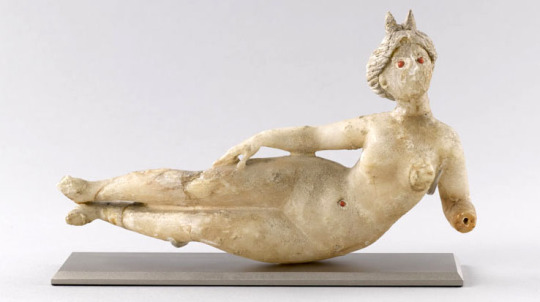
A Parthian statue of Nanaya with a crescent diadem (Louvre; reproduced here for educational purposes only. Identification follows Andrea Sinclair's proposal)
The Seleucid dynasty was eventually replaced by the Parthians. This period is often considered a symbolic end of ancient Mesopotamian religion in the strict sense. Traditional religious institutions were already slowly collapsing in Achaemenid and Seleucid times as the new dynasties had limited interest in royal patronage. Additionally, cuneiform fell out of use, and by the end of the first half of the first millennium CE the art of reading and writing it was entirely lost. This process did not happen equally quickly everywhere, obviously, and some deities fared better than others in the transitional period before the rise of Christianity and Islam as the dominant religions across the region. Nanaya was definitely one of them, at least for a time.
In Parthian art Nanaya might have developed a distinct iconography: it has been argued she was portrayed as a nude figure wearing only some jewelry (including what appears to be a navel piercing and a diadem with a crescent. The best known example is probably this standing figure, one of my all time favorite works of Mesopotamian art:

Parthian Nanaya (wikimedia commons; identification courtesy of the Louvre website and J. G. Westenholz)
For years Wikipedia had this statue mislabeled as “Astarte” which makes little sense considering it comes from a necropolis near Babylon. There was also a viral horny tweet which labeled it as “Asherah” a few months ago (I won’t link it but I will point out in addition to getting the name wrong op also severely underestimated the size). This is obviously even worse nonsense both on spatial and temporal grounds. Even if the biblical Asherah was ever an actual deity like Ugaritic Athirat and Mesopotamian Ashratum, it is highly dubious she would still be worshiped by the time this statue was made. It’s not even certain she ever was a deity, though. Cognate of a theonym is not automatically a theonym itself, and the Ugaritic texts and the Bible, even if they share some topoi, are separated by centuries and a considerable distance. This is not an Asherah post though, so if this is a topic which interests you I recommend downloading Steve A. Wiggins’ excellent monograph A Reassessment of Asherah: With Further Considerations of the Goddess.
The last evidence for the worship of Nanaya in Mesopotamia is a Mandaean spell from Nippur, dated to the fifth or sixth century CE. However, at this point Nanaya must have been a very faint memory around these parts, since the figure designated by this name is evidently male in this formula. That was not the end of her career, though. The system of beliefs she originated and thrived in was on its way out, but there were new frontiers to explore.
A small disgression is in order here: be INCREDIBLY wary of claims about the survival of Mesopotamian tradition in Mesopotamia itself past the early middle ages. Most if not all of these come from the writing of Simo Parpola, who is a 19th century style hyperdiffusionist driven by personal religious beliefs based on gnostic christianity, which he believes was based on Neo-Assyrian state religion, which he misinterprets as monotheism, or rather proto-christianity specifically (I wish I was making this up). I personally do not think a person like that should be tolerated in serious academia, but for some incomprehensible reason that isn’t the case.
New frontiers: Nanaya in Bactria
The key to Nanaya’s extraordinarily long survival wasn’t the dedication to her in Mesopotamia, surprisingly. It was instead her introduction to Bactria, a historical area in Central Asia roughly corresponding to parts of modern Afghanistan, Tajikistan and Uzbekistan. The early history of this area is still poorly known, though it is known that it was one of the “cradles of civilization” not unlike Mesopotamia, the Indus Valley or Mesoamerica. The so-called “Oxus civilization” or “Bactria-Margiana Archaeological Complex” flourished around 2500-1950 BCE (so roughly contemporarily with the Akkadian and Ur III empires in Mesopotamia). It left behind no written records, but their art and architecture are highly distinctive and reflect great social complexity.
I sadly can’t spent much time discussing them here though, as they are completely irrelevant to the history of Nanaya (there is a theory that she was already introduced to the east when BMAC was extant but it is incredibly implausible), so I will limit myself to showing you my favorite related work of art, the “Bactrian princess”:

Photo courtesy of Louvre Abu Dhabi, reproduced here for educational purposes only.
By late antiquity, which is the period we are concerned with here, BMAC was long gone, and most of the inhabitants of Bactria spoke Bactrian, an extinct Iranian language. How exactly they were related to their BMAC forerunners is uncertain. Their religious beliefs can be compared to Zoroastrianism, or rather with its less formalized forerunners followed by most speakers of Iranian languages before the rise of Zoroaster. However, there were many local peculiarities. For example, the main deity was the personified river Oxus, not Ahura Mazda. Whether this was a relic of BMAC religion is impossible to tell.We do not know exactly when the eastward transfer of Nanaya to Bactria happened. The first clear evidence for her presence in central Asia comes from the late first century BCE, from the coins of local rulers, Sapadbizes and Agesiles. It is possible that her depictions on coinage of Mesopotamian and Persian rulers facilitated her spread. Of course, it’s also important to remember that the Aramaic script and language spread far to the east in the Achaemenid period already, and that many of the now extinct Central Asian scripts were derived from it (Bactrian was written with the Greek script, though). Doubtlessly many now lost Aramaic texts were transferred to the east.
There’s an emerging view that for unclear reasons, under the Achaemenids Mesopotamian culture as a whole had unparalleled impact on Bactria. The key piece of evidence are Bactrian temples, which often resemble Mesopotamian ones. Therefore, perhaps we should be wondering not why Nanaya spread from Mesopotamia to Central Asia, but rather why there were no other deities who did, for the most part. That is sadly a question I cannot answer. Something about Nanaya simply made her uniquely appealing to many groups at once.
While much about the early history of Nanaya in Central Asia is a mystery, it is evident that with time she ceased to be viewed as a foreign deity. For the inhabitants of Bactria she wasn’t any less “authentically Iranian” than the personified Oxus or their versions of the conventional yazatas like Sraosha. Frequently arguments are made that Nanaya’s widespread adoption and popularity could only be the result of identification between her and another deity.Anahita in particular is commonly held to be a candidate. However, as stressed by recent studies there’s actually no evidence for this.
What is true is that Anahita is notably missing from the eastern Iranian sources, despite being prominent in the west from the reign of the Achaemenid emperor Artaxerxes II onward. However, it is clear that not all yazatas were equally popular in each area - pantheons will inevitably be localized in each culture. Furthermore, Anahita’s character has very little in common with Nanaya save for gender. Whether we are discussing her early not quite Zoroastrian form the Achaemenid public was familiar with or the contemporary yazata still relevant in modern Zoroastrianism, the connection to water is the most important feature of her. Nanaya didn’t have such a role in any culture.
Recently some authors suggested a much more obvious explanation for Anahita’s absence from the eastern Iranian pantheon(s). As I said, eastern Iranian communities venerated the river Oxus as a deity (or as a yazata, if you will). He was the water god par excellence, and in Bactria also the king of the gods. It is therefore quite possible that Anahita, despite royal backing from the west, simply couldn’t compete with him. Their roles overlapped more than the roles of Anahita and Nanaya. I am repeating myself but the notion of interchangeability of goddesses really needs to be distrusted almost automatically, no matter how entrenched it wouldn’t be. While we’re at it, the notion of alleged interchangeability between Anahita and Ishtar is also highly dubious, but that’s a topic for another time.

Nana (Nanaya) on a coin of Kanishka (wikimedia commons)
Nanaya experienced a period of almost unparalleled prosperity with the rise of the Kushan dynasty in Bactria. The Kushans were one of the groups which following Chinese sources are referred to as Yuezhi. They probably did not speak any Iranian language originally, and their origin is a matter of debate. However, they came to rule over a kingdom which consisted largely of areas inhabited by speakers of various Iranian languages, chiefly Bactrian. Their pantheon, documented in royal inscriptions and on coinage, was an eerie combination of mainstays of Iranian beliefs like Sraosha and Mithra and some unique figures, like Oesho, who was seemingly the reflection of Hindu Shiva. Obviously, Nanaya was there too, typically under the shortened name Nana.
The most famous Kushan ruler, emperor Kanishka, in his inscription from Rabatak states that kingship was bestowed upon him by “Nana and all the gods”. However, we do not know if the rank assigned to her indicates she was the head of the dynastic pantheon, the local pantheon in the surrounding area, or if she was just the favorite deity of Kanishka. Same goes for the rank of numerous other deities mentioned in the rest of the inscription. Her apparent popularity during Kanishka’s reign and beyond indicates her role should not be downplayed, though.
The coins of Kanishka and other Bactrian art indicate that a new image of Nanaya developed in Central Asia. The Artemis-like portrayals typical for Hellenistic times continue to appear, but she also started to be depicted on the back of a lion. There is only one possible example of such an image from the west, a fragmentary relief from Susa, and it’s roughly contemporary with the depictions from Bactria. While it is not impossible Nanaya originally adopted the lion association from one of her Mesopotamian peers, it is not certain how exactly this specific type of depictions originally developed, and there is a case to be made that it owed more to the Hellenistic diffusion of iconography of deities such as Cybele and Dionysus, who were often depicted riding on the back of large felines.
The lunar symbols are well attested in the Kushan art of Nanaya too. Most commonly, she’s depicted wearing a diadem with a crescent. However, in a single case the symbol is placed behind her back. This is an iconographic type which was mostly associated with Selene at first, but in the east it was adopted for Mah, the Iranian personification of the moon. I’d hazard a guess that’s where Nanaya borrowed it from - more on that later.
The worship of Nanaya survived the fall of the Kushan dynasty, and might have continued in Bactria as late as in the eighth century. However, the evidence is relatively scarce, especially compared with yet another area where she was introduced in the meanwhile.
Nanaya in Sogdia: new home and new friends
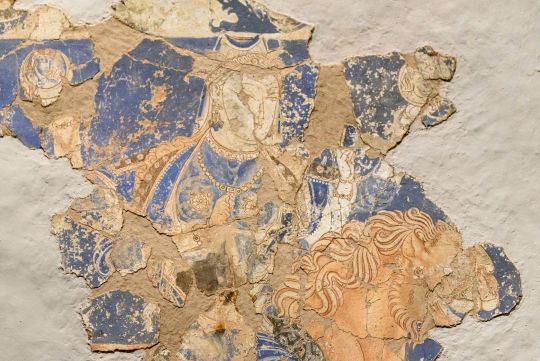
A Sogdian depiction of Nanaya from Bunjikat (wikimedia commons)
Presumably from Bactria, Nanaya was eventually introduced to Sogdia, its northern neighbor. I think it’s safe to say this area effectively became her new home for the rest of her history.
Like Bactrians, the Sogdians also spoke an eastern Iranian language, Sogdian. It has a direct modern descendant, Yaghnobi, spoken by a small minority in Tajikistan. The religions Sogdians adhered to is often described as a form of Zoroastrianism, especially in older sources, but it would appear that Ahura Mazda was not exactly the most popular deity. Their pantheon was seemingly actually headed by Nanaya. Or, at the very least, the version of it typical for Samarkand and Panijkant, since there’s a solid case to be made for local variety in the individual city-states which made up Sogdia. It seems that much like Mesopotamians and Greeks centuries before them, Sogdians associated specific deities with specific cities, and not every settlement necessarily venerated each deity equally (or at all). Nanaya's remarkable popularity is reflected by the fact the name Nanaivandak, "servant of Nanaya", is one of the most common Sogdian names in general.
It is agreed that among the Sogdians Panjikant was regarded as Nanaya’s cult center. She was referred to as “lady” of this city. At one point, her temple located there was responsible for minting the local currency. By the eighth century, coins minted there were adorned with dedications to her - something unparalleled in Sogdian culture, as the rest of coinage was firmly secular. This might have been an attempt at reasserting Sogdian religious identity in the wake of the arrival of Islam in Central Asia.
Sogdians adopted the Kushan iconography of Nanaya, though only the lion-mounted version. The connection between her and this animal was incredibly strong in Sogdian art, with no other deity being portrayed on a similar mount. There were also innovations - Nanaya came to be frequently portrayed with four arms. This reflects the spread of Buddhism through central Asia, which brought new artistic conventions from India. While the crescent symbol can still be found on her headwear, she was also portrayed holding representations of the moon and the sun in two of her hands.
Sometimes the solar disc and lunar orb are decorated with faces, which has been argued to be evidence that Nanaya effectively took over the domains of Mah and Mithra, who would be the expected divine identities of these two astral bodies. She might have been understood as controlling the passage of night and day. It has also been pointed out that this new iconographic type is the natural end point of the evolution of her astral role.
Curiously, while no such a function is attested for Nanaya in Bactria, in Sogdia she could be sometimes regarded as a warlike deity. This is presumably reflected in a painting showing her and an unidentified charioteer fighting demons.

The "Sogdian Deities" painting from Dunhuang, a possible depiction of Nanaya and her presumed spouse Tish (wikimedia commons)
Probably the most fascinating development regarding Nanaya in Sogdia was the development of an apparent connection between her and Tish. This deity was the Sogdian counterpart of one of the best known Zoroastrian yazatas, Tishtrya, the personification of Sirius. As described in the Tištar Yašt, the latter is a rainmaking figure and a warlike protector who keeps various nefarious forces, such as Apaosha, Duzyariya and the malign “worm stars” (comets), at bay. Presumably his Sogdian counterpart had a similar role.
While this is not absolutely certain, it is generally agreed that Nanaya and Tish were regarded as a couple in central Asia (there’s a minority position she was instead linked with Oesho, though). Most likely the fact that in Achaemenid Persia Tishtrya was linked with Nabu (and by extension with scribal arts) has something to do with this. There is a twist to this, though.
While both Nabu and the Avestan Tishtrya are consistently male, in Bactria and Sogdia the corresponding deity’s gender actually shows a degree of ambiguity. On a unique coin of Kanishka, Tish is already portrayed as a feminine figure distinctly similar to Greek Artemis - an iconographic type which normally would be recycled for Nanaya. There’s also a possibility that a feminine, or at least crossdressing, version of Tish is portrayed alongside Nanaya on a painting from Dunhuang conventionally referred to as “Sogdian Daēnās” or “Sogdian Deities”, but this remains uncertain. If this identification is correct, it indicates outright interchange of attributes between them and Nanaya was possible.
The final frontier: Nanaya and the Sogdian diaspora in China
Sogdians also brought Nanaya with them to China, where many of them settled in the Six Dynasties and Tang periods. An obviously Sinicized version of her, accompanied by two attendants of unknown identity, is portrayed on a Sogdian funerary couch presently displayed in the Miho Museum.
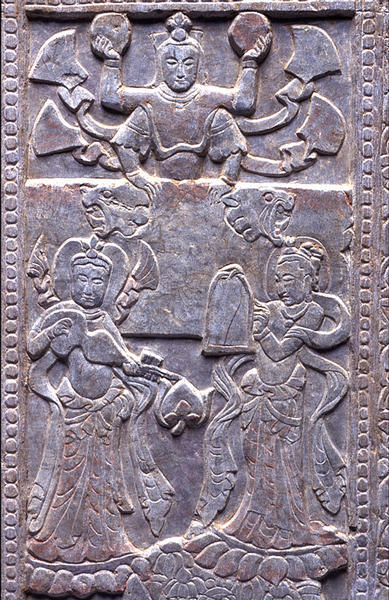
Nanaya (top) on a relief from the Miho funerary couch (Miho Museum; reproduced here for educational purposes only)
For the most part the evidence is limited to theophoric names, though. Due to unfamiliarity with Sogdian religious traditions and phonetic differences between the languages there was no consistent Chinese transcription of Nanaya’s name. I have no clue if Chinese contemporaries of the Sogdians were always aware of these elements in personal names referred to a deity. There is a fringe theory that Nanaya was referred to as Nantaihou (那那女主, “queen Nana”) in Chinese. However, the evidence is apparently not compelling, and as I understand the theory depends in no small part on the assertion that a hitherto unattested alternate reading of one of the signs was in use on the western frontiers of China in the early first millennium CE. The alleged Nantaihou is therefore most likely a misreading of a reference to a deceased unnamed empress dowager venerated through conventional ancestor worship, as opposed to Nanaya.
Among members of the Sogdian diaspora, in terms of popularity Nanaya was going head to head with Jesus and Buddha. The presence of the latter two reflected the adoption of, respectively, Manichaeism and Buddhism. Manicheans seemingly were not fond of Nanaya, though, and fragments of a polemic against her cult have been identified. It seems ceremonies focused on lamentations were the main issue for the Manichaeans. Sadly there doesn’t seem to be any worthwhile study of possible Mesopotamian influence on that - the only one I found is old and confuses Nanaya with Inanna.
We do not have much of an idea how Buddhists viewed Nanaya, though it is worth noting a number of other Sogdian deities were incorporated into the local form of Mahayana (unexpectedly, one of them was Zurvan). It has also been argued that a Buddhist figure, Vreshman (Vaisravana) was incorporated into Nanaya’s entourage.
Nanaya might additionally be depicted in a painting showing Buddha’s triumph over Mara from Dunhuang. Presumably her inclusion would reflect the well attested motif of local deities converting to Buddhism. It was a part of the Buddhist repertoire from the early days of this religion and can be found in virtually every area where this religion ever spread. Nanaya is once again in elevated company here, since other figures near her have been tentatively interpreted as Shiva, Vishnu, Kartikeya and… Zoroaster.
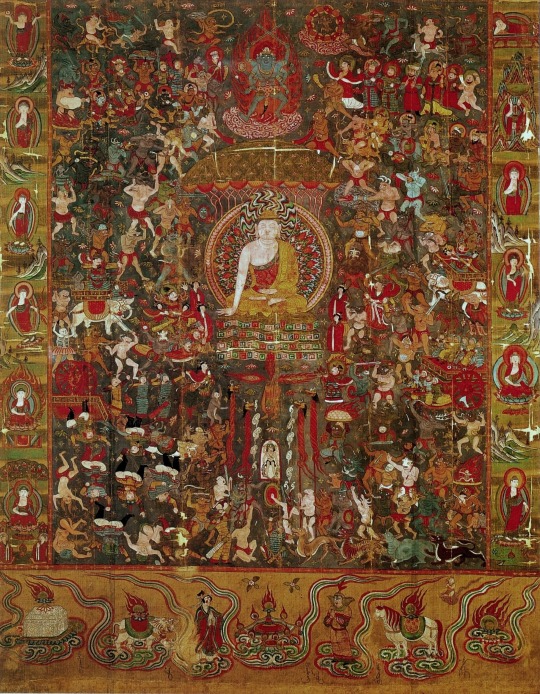
Buddha conquering Mara (maravijaya) on a painting from Dunhuang (wikimedia commons)

zoom in on a possible depiction of Nanaya next to a demon suspiciously similar to Tove Jansson’s Fillyjonk
To my best knowledge, the last absolutely certain attestation of Nanaya as an actively worshiped deity also comes from the western frontier of China. A painting from Dandan Oilik belonging to the artistic tradition of the kingdom of Khotan shows three deities from the Sogdian pantheon: the enigmatic Āδβāγ (“highest god”; interpreted as either Indra, Ahura Mazda or a combination of them both) on the left, Weshparkar (a later version of Kushan Oesho) on the right and Nanaya in the center. It dates to the ninth or tenth century.
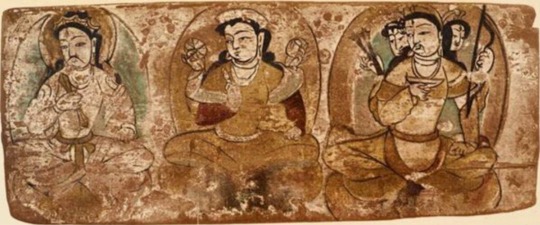
Nanaya (center) on the Dandan Oilik painting (wikimedia commons)
We will probably never know what Nanaya’s last days were like, though it is hard to imagine she retained much relevance with the gradual disappearance of Sogdian culture both in Sogdia and in China in the wake of, respectively, the rise of Islam in Central Asia and the An Lushan rebellion respectively. Her history ultimately most likely ended with a whimper rather than a bang.
Conclusions and reflections
Obviously, not everything about Nanaya could be covered in this article - there is enough material to warrant not one, but two wiki articles (and I don't even think they are extensive enough yet). I hope I did nonetheless manage to convey what matters: she was the single most enduring Mesopotamian deity who continued to be actually worshiped. She somehow outlived Enlil, Marduk, Nergal and even Inanna, and spread further than any of them ever did.
It does not seem like her persistence was caused by some uniquely transcendent quality, and more to a mix of factors we will never really fully understand and pure luck. She is a far cry from the imaginary everlasting universal goddesses such longevity was attributed to by many highly questionable authors in the past, from Frazer to Gimbutas. Quite the opposite, once you look into the texts focused on her she comes across as sort of pathetic. After all, most of them are effectively ancient purple prose.
And yet, this is precisely why I think Nanaya matters. To see how an author approaches her is basically a litmus test of trustworthiness - I wish I was kidding but this “Nanaya method” works every time. To even be able to study her history, let alone understand it properly, one has to cast away most of the dreadful trends which often hindered scholarship of ancient deities, and goddesses in particular, in the past. The interchangeability of goddesses; the Victorian mores and resulting notion that eroticism must be tied to fertility; the weird paradigms about languages neatly corresponding to religions; and many others. And if nothing else, this warrants keeping the memory of her 3000 years long history alive through scholarship (and, perhaps, some media appearances).
Bibliography
Julia M. Asher-Greve & Joan Goodnick Westenholz, Goddesses in Context: On Divine Powers, Roles, Relationships and Gender in Mesopotamian Textual and Visual Sources (2013)
Paul-Alain Beaulieu, The Pantheon of Uruk During the Neo-Babylonian Period (2003)
idem, Nabû and Apollo: The Two Faces of Seleucid Religious Policy in: Orient und Okzident in Hellenistischer Zeit (2014)
Matteo Compareti, Nana and Tish in Sogdiana (2017)
idem, The So-Called "Pelliot Chinois 4518.24". Illustrated Document from Dunhuang and Sino-Sogdian Iconographical Contacts (2021)
Olga Drewnowska-Rymarz, Mesopotamian Goddess Nanāja (2008)
Benjamin R. Foster, Before the Muses: an Anthology of Akkadian Literature (2005)
Andrew R. George & Manfred Krebernik, Two Remarkable Vocabularies: Amorite-Akkadian Bilinguals! (2022)
Valerie Hansen, Kageyama Etsuko & Yutaka Yoshida, The Impact of the Silk Road Trade on a Local Community: The Turfan Oasis, 500-800 in: Les sogdiens en Chine (2005)
Wilfred G. Lambert, Babylonian Creation Myths (2013)
Enrico Marcato, An Aramaic Incantation Bowl and the Fall of Hatra (2020)
Christa Müller-Kessler & Karlheinz Kessler, Spätbabylonische Gottheiten in spätantiken mandäischen Texten (1999)
Lilla Russel-Smith, Uygur Patronage in Dunhuang. Regional Art Centres on the Northern Silk Road in the Tenth and Eleventh Centuries (2005)
idem, The 'Sogdian Deities' Twenty Years on: A Reconsideration of a Small Painting from Dunhuang in: Buddhism in Central Asia II. Practices and Rituals, Visual and Material Transfer (2022)
Tonia M. Sharlach, An Ox of One's Own. Royal Wives and Religion at the Court of the Third Dynasty of Ur (2017)
Michael Shenkar, Intangible Spirits and Graven Images: The Iconography of Deities in the Pre-Islamic Iranian World (2014)
idem, The Religion and the Pantheon of the Sogdians (5th-8th Centuries CE) in Light of their Sociopolitical Structures (2017)
idem, The So-Called "Fravašis" and the "Heaven and Hell" Paintings, and the Cult of Nana in Panjikent (2022)
Marten Stol, Nanaja in: Reallexikon der Assyriologie, vol. 9 (1998)
Michael P. Streck & Nathan Wasserman, More Light on Nanāya (2013)
Aaron Tugendhaft, Gods on Clay: Ancient Near Eastern Scholarly Practices and the History of Religions in: Canonical Texts and Scholarly Practices. A Global Comparative Approach (2016)
Joan Goodnick Westenholz, Nanaya, Lady of Mystery in: Sumerian Gods and Their Representations (1997)
idem, Trading the Symbols of the Goddess Nanaya in: Religions and Trade. Religious Formation, Transformation and Cross-Cultural Exchange between East and West (2014)
Xinjiang Rong, The Colophon of the Manuscript of the Golden Light Sutra Excavated in Turfan and the Transmission of Zoroastrianism to Gaochang in: The Silk Road and Cultural Exchanges between East and West (2022)
Gioele Zisa, The Loss of Male Sexual Desire in Ancient Mesopotamia. ›Nīš Libbi‹ Therapies (2021)
#mesopotamian mythology#sumerian mythology#mythology#bactrian mythology#sogdian mythology#sogdia#nanaya
424 notes
·
View notes
Text
Note: I really like the Aranara and everyone else seems to like the Aranaras as well! I didn’t fully finish this fic idea (because I haven’t finished the quest yet). Honestly this fic could go any sagau way,,, so read it as you want lol
Warning: not proofread! I'm sick, it might have some mistakes
If you want more Aranara with sagau/isekai reader, please comment/reblog!

‘Welcome, world’
Is this how you’re going to die? Lost in the woods, cold and alone, and somehow in your favourite video game?
You’ve seen way too many isekai animes-, surely there is another part to the story! Maybe the main character will find you, though, you’re certain they won’t. Whichever twin is the traveller, they would be far away in Sumeru city.
You sigh and huddle closer to the tree. Perhaps if you went outside more often, this wouldn’t have happened. You at least wanted to meet one of your favourite characters before you’d die. You’d even be fine with an npc- as long as they’d help you out.
‘Hello world’
You move your head up from your arms when you hear the little squeaky voice. You previously brought your knees up to your chest and wrapped your arms around them to keep yourself hidden and warm. ‘…Huh?’ You look around for a moment. You heard a voice, right?
‘Down here.’ A small blob of green jumps up and down and waves with its hand (or is it a paw?) in the air. ‘Aranara heard your call from the forest.’ It wiggles closer to your crouched up form. ‘I’m Arama and these are my brothers and sisters.’
A handful different colored -yet similar- forest creatures appear. Some of them carry fruits while others stick closer to the back. Are they shy?
As Arama continues to talk, you’re slowly starting to put the story together. You’re somehow in Genshin and you’ve definitely met these small creatures before! ‘You’re an Aranara…’
Ever since you woke up in this forest you’ve been hearing a melody. Its soft and strangely familiar. You tried to follow it but the sounds seemed to echo around you. Was it the Aranara trying to communicate?
The little guy stops and wiggles its body to fully face you. ‘I’m Arama, from Varanara, and you’re the world. We come here to help.’ Another small guy wiggles over and drops the fruits at the side of your body.
‘You don’t need to be afraid. The forest will remember, and so will you.’

After that your memories start to get fuzzy. You don’t remember anything besides waking up in Varanara. You barely fit in the small houses, so they put your sleeping body on a flowerbed and waited until you were awake.
#genshin#genshin impact#genshin x reader#genshin impact x reader#sagau#sagau x reader#genshin impact sagau#genshin sagau#isegau#genshin isekai#genshin isegau#aranara#sagau isekai#imposter sagau#sagau cult au
4K notes
·
View notes
Text
Conlanging Issues: A Compendium
NOTE: This question was submitted before the Nov 1, 2023 reopening and may not adhere to all rules and guidelines. The ask has been abridged for clarity.
Most of my questions are about linguistics. […] One of the major locations in my story is a massive empire with cultural inspirations ranging from North Africa in the far south to Mongolia/Russia in the far north […] The middle region is where the capital is and is the main root of culture, from which Ive been taking inspiration from Southwest Asia […], but most notably southern regions of India. I've tried to stick to the way cities are named in Sanskrit-based languages but added the names of stars to the front (because the prevalent religion of this region worships the stars [...]). So Ive ended up with names like Pavoprayag, Alyanaga, Alkaiduru, Alcorpura, Cygnapete, etc. Is this a consistent naming system or should I alter it in some way? The empire itself is named the Arcana Empire since [...] each act of my story is named after a tarot card [...].
Another region in my story is based more on parts of South China and North Vietnam, so I've tried to stick to names with a Chinese origin for that. I understand the significance of family names in southwest [sic] Asia, so I wanted to double check [...]. They have only two short given names. Based on the birth order of the child, the first half of the name comes from the fathers family and the second half from the mothers family. It is seen as disrespectful not to use both names because using only one is seen as denouncing that side of your family. Thus I have names like Su Yin, Dai Jun, and Yi Wen for some of the characters from this region, and the city itself that they are from is named Bei Fen.
On the other hand, Im having further trouble naming characters. […] Ive been trying to give my human characters names from real human cultures to distinguish them from the website-generated names of say, orcs, elves, dwarves, etc, but I think I should change many of the names Ive used to be more original and avoid fracturing real world cultures for the sake of my worldbuilding. […] Im still very weak in the linguistics area (even after four years of French, sigh) and am having trouble finding where to read about naming patterns so I can make new ones up. I read your naming guides but am still having trouble on where to start for specific languages. […] Im trying to look into Sanskrit, Turkish, and Persian specifically.
You're Going Too Broad
In my opinion, you’re casting too wide a net. You mentioned looking into Sanskrit, Turkish, and Persian to develop fantasy names. These languages are very different from one another, so unless you’re using them separately for very different parts of your world, it will be hard to draw inspiration from them in a way that makes sense. You’re taking on a huge amount of research in order to worldbuild cultures that span a massive geographical area (basically all of North Africa and Asia?) and have very little in common. Are you sure you want to take on that task?
I could see it being more manageable if most of your story is set in a small region of this world, which you will then research in depth to make sure you’re being as specific as possible.
Taking Persian as an example, you’ll have to decide whether you want to use Old Persian, Middle Persian, or Modern Persian. Each of these comes with a different alphabet and historical influences. They’re also associated with different periods of time and corresponding cultural and social markers. Once you’ve decided exactly when and where you want to start from, you can then expand the borders of your area of focus. For example, if you’ve decided to draw inspiration from Achaemenid Persia, you can then look at the languages that were spoken in the Achaemenid Empire. A quick Google search tells me that while Old Persian was the empire’s official language, they also used Aramaic, Akkadian, Median, Greek, and Elamite (among, I’m sure, many many others and many more regional variations). Further research into each of these will give you ethnic groups and bordering nations that you can draw more inspiration from to expand out your worldbuilding.
Don’t forget to make sure you’re staying within the same time period in order to keep things consistent. It’s a lot of work, and this is only for a small portion of the continent-spanning worldbuilding you’re trying to do.
You can get away with painting the rest of the continent in broad strokes without too much depth if the story doesn’t go there and you don’t have any main characters from those parts of the world. Otherwise, you’ll need to put this same level of detail into your worldbuilding for the area with Turkish-inspired names, and again for the area with Sanskrit-inspired names, and so on.
I know this isn’t what you were asking, but I honestly have a hard time helping you figure out where to start because your ask is so broad I don’t quite know where I would start myself. So, this is my advice: focus down on one region and time period and go from there. Feel free to write back once you’ve picked a narrower focus that we could help you with.
- Niki
So there’s logistical issues in regards to your naming system for southern China-coded regions. One issue is history: mainly on how there is not simply one language in China but multiple due to having a lot of ethnic groups and the size of China. South China in particular has different dialects and languages than the North as seen in this map of Chinese languages and dialects. There’s also how historically Mandarin was not the official language until 1913 in China and historical China saw vast changes in territory dependent on the dynasty. Before then, Mandarin was primarily a northern Chinese language based in Beijing while southern China had its own languages, dialects, and dynamics. Not to mention, historical China saw an evolution of language just like English has Old English, Middle English, Early Modern English, and Modern English. For instance, Vietnam was once part of China during the Tang Dynasty and at another point, it was not part of China.
-Mod Sci
If You’re Borrowing Whole Words or Elements, Research More
The other issue is inconsistency with the cultures you’re deriving this conlang from. In regards to “two given names,” the Chinese name I was given was one syllable and then I would have a last name that was also one syllable. There’s also how not every family is perfect. Not every marriage is sanctioned and some children may come from single parents. Some families may not cooperate with marriage and sometimes children may be abandoned with unknown parents. There does not seem to be contingencies for these names under this conlang system.
The main problem with conlangs is that one needs to truly understand the languages one is drawing from. Tolkein managed to create conlangs due to training in linguistics. Mandarin is already a difficult language with multiple tones, and trying to use it for conlangs without knowledge of how Mandarin works or a good foundation in linguistics is just a Sisyphean endeavor.
-Mod Sci
Four years of French wouldn’t have taught you about linguistics as a science or anything about the language families you’ve listed - Indo-Iranian, Sino-Tibetan, and Turkic, nor any Asian naming conventions. I agree with Niki that you need to narrow down your research.
Pur/pura means city in Sanskrit (ex: Gurdaspur, Hoshiarpur). Prayag is a place where pilgrimages are done. Naga isn’t a place name in Sanskrit (google says it means snake), nagar is and it means town. X Nagar is a very common name for places (Ex: Rajinder Nagar). Many cities in Karnataka have names ending in uru (Bengaluru, Mysuru, Mangaluru, Tumakuru, etc) but the language of Karnataka is Kannada - a Dravidian language and completely different family from Sanskrit (Indo-Aryan). I’m not sure where “pete” came from. “Bad” and “vaal” are common suffixes for places too (Ex: Faisalabad, Allahabad). A disclaimer that I do not speak Sanskrit, I speak Punjabi, which is a descendant of Sanskrit and in the same linguistic family (Indo-Aryan languages).
- SK
Also, This Is Not…Really Conlanging.
Hi OP. Linguistics refers to the science of studying how languages work, not the discipline of learning languages. And nothing shows that gap more than how you have thus far approached constructing fictional languages and toponyms.
The reason why Sci and SK have a lot to say about your place names is because they don't resonate—you have borrowed whole words into your toponyms (place names) from a variety of languages—without an accurate understanding of what these words mean, how they’re pronounced, where they’re derived from—and expected them to work together. I suggest you read the links below on why conlanging is not as simple as choosing some languages and mashing their IRL words together:
Why Using Random Languages Wholesale in your Fantasy is a Bad Idea
Pitfalls of Mashing Countries and Languages in Coding
In your city names, for example, you’re using star names from multiple languages that use different sets of sounds represented by different sets of historical spelling rules. “Cygn-” and “Arcana” stick out like a sore thumb—the fact that one “c” is /s/ and one is /k/ is an obvious flag that they are Latin-derived English borrowings. This is because spelling rules were created in Middle English to make sense of the mix of “c” pronunciations across words of Indo-European origin due to a historical split called the Centum-Satem division. This is a phenomenon that is very specific to our world history, and to the history of English at that. Ironically, in your attempt to avoid stock fantasy names (which also often fall into the Latin-derived English pit), you are taking the exact same approach to naming.
Like Niki said, your selections are far too broad to code under a single umbrella. Do you expect that whatever language that city name came from runs the full gamut of sound inventory & spelling variety that spans multiple continents and hundreds of languages? Because that’s not how languages work. (And yes, I mean hundreds. Indigenous languages and linguistic diversity are a thing. See Niki’s note about just the languages in Persia. And nation-states bulldozing over those languages and pretending it’s just one language is a thing. See Sci’s note about China.) I haven't even talked about the variation in morphology (how words are formed) or syntax (sentence structure).
Please just read or re-read my guide on “naming conlangs” in this post and start from there.
~ Rina
PSA ON CONLANGING AND FANTASY NAMES:
For fantasy language asks submitted after Nov 1, 2023, the asker must indicate that they have read Mod Rina’s conlanging posts linked in FAQ 2 (Guides and Posts by Topic) of the Masterpost under the question “How do I make a fictional language for my story?” While this is an older ask, we are posting it as an example to our followers.
Per our new rules, any questions that can be directly answered in or extrapolated from the FAQs, or questions that indicate that the relevant resources haven’t been read, will be deleted with a note in the Deletion Log explaining why.
As always, if this post was helpful or educational to you, please consider tipping the relevant mods: SK, Niki, Sci, and Rina.
Edited for terminology errors
319 notes
·
View notes
Text
Etymology of TLT Character Names
Wanted to provide a fandom resource for analysis and theorizing. Since House names are explained in GTN, this list will just focus on first names. DM me for sources. Enjoy <3
Gideon
Biblical prophet, military leader, and judge, meaning "feeler," "hewer," or "one who cuts down." According to narrative, the Israelites had forgotten their god for 40 years and were punished by assaults from enemy tribes. After Israel turned back to God for aid, Gideon, an unnoteworthy Israelite, was delivered the message by an angel that he should lead Israel against its enemies. Gideon requested three miracles be done by God to prove his and God's ability to do this task, which God then performed. Gideon then completes God's tasks, including destroying an idol of Baal in the Israelite camp and displacing a much larger enemy encampment. Gideon delivered 40 years of peace for Israel during his lifetime and refused kinghood and dynasty when offered by his people. However, upon his death, the Israelites returned to worshipping Baal. A "Gideonic victory" can mean winning a battle against the odds.
Harrowhark
Harrowing - to use a piece of farming equipment to level soil, break rocks, and kill weeds to ready the dirt for seed growth. Also refers to the Harrowing of Hell, a non-Biblical, early to middle English traditional episode in which Jesus, upon death by crucifixtion, enters the Underworld to preach salvation to souls interned there before his birth, thus allowing them to enter Heaven. This tradition has been canonized by Catholic theology.
Hark - the first word of many ancient texts or announcements, meaning "listen." Biblical angelic speeches often begin with "hark."
Judith
The feminine of Judah, a Biblical Hebrew name meaning "praised," "woman of Judea/Jewess." The name Judith appears twice in the deuterocanonical Bible: once as one of Esau's wives and seperately as the titular character in the Book of Judith (a book not part of the canonized Bible). In the Book of Judith, Judith is described as a widow who uses her wit, charm, and skills of seduction to be invited to the private tent of Holofernes, the general of the enemy Assyrian army who had laid siege to her city. Judith is able to get Holofernes drunk and overpowers him, decapitates him, and steals his head to show to her city. She is of the few illustrations of the "ideal Jewish woman."
Marta
Derived from Aramaic, meaning "the daughter," "the lady," and "dedicated to Mars"
Isaac
Meaning "he laughs," referring to the father of the Biblical character's laugh of disbelief when God told him, Abraham, that his nonogenarian wife would conceive his child. Isaac is one of the three patriarchs of Israel, grandfather to the 12 tribes. When Isaac was a child, God commanded Abraham to take him up a mountain and sacrifice his child in His name. When Abraham proved his obedience, God provided a ram to sacrifice instead of Isaac. Isaac went on to marry Rebekah; though they eventually believed her to be barren, after Isaac prayed to God, Rebekah concieved twin boys, Esau and Jacob, at an old age, just as his mother did. Rebekah grew to prefer Jacob. Later, due to Sarah and Jacob's scheming, Isaac gave Esau's birthright to his second-born son, Jacob. Jacob would live on to father the twelve tribes of Israel.
Jeannemary
This specific spelling seems to be an invention of Tazmuir, but the duel components of the name are significant. Firstly, "Jean-Marie" is a French masculine name. Jeanne is the feminine form of the English "John." "Jeanne" can be traced to a Biblical Hebrew name, meaning "God is gracious." The most notable historical character of the same name is Jeanne d'Arc, a young female military leader who acted under divine guidance. Upon instruction of archangels and saints, Jeanne fought in pursuit of the coronation of Charless VII during the 100 Years War. Her leadership led to multiple military victories but was punctuated by multiple failures. The unsuccessful relief of a besieged city led to her capture and deliverance to the English, who tried her for blasphemy by wearing men's clothes and refusing submission to Church authority. Found guilty, Jeanne was burned at the stake at 19.
Mary is the most notable feminine name of the Christian Bible, referring predominately to Mary, mother of Jesus Christ, Mary Bethany, and Mary Magdalene, a female disciple of Jesus. Mary was born immaculately - without sin - so that she would be a pure vessel to carry Jesus, who she concieved as a virgin. Mary Bethany was a friend of Jesus and sister to Lazarus. She was deeply emotional about her brother's passing, which persuaded Jesus to resurrect her brother from the grave. Mary Magdalene was a probably wealthy Jewish woman who aided Jesus' teachings. As a loyal apostle, she was a witness at both His crucifixtion and resurrection.
Coronabeth
"Coronabeth," like "Jeannemary," is an obvious Tazmuir invention. "Corona" refers to both the part of the body that resembles a crown and to a colored circular frame around a stellar body, usually caused by its atmosphere.
"Beth" is derived from both "Elizabeth" ("God is my oath") and "Bethany" ("House of Figs"). The suffix -beth comes from Hebrew origins, meaning "house."
Ianthe
From the Ancient Greek, meaning "violet flower" or "she who delights." She was one of the 3,000 water-nymphs called Oceanides, daughters of the Titans. Ianthe and her sisters served as a companion to Persephone when she was in Hades. She is also a character in Ovid's Metamorphosis as the beautiful fiancé to Iphis, a character who has her/his gender changed by the goddess Isis.
Note on the Tridentarii: Coronabeth was almost called "Cainabeth" and Ianthe "Abella" after the two Biblical brother characters, Cain and Abel. In the narrative, God preferred Abel's divine sacrifices and loved him more than his brother. In a jealous rage, Cain killed Abel and hid from his crime, his family, and his God. When God asked him, "Where is your brother?" Cain returned, "I am not my brother's keeper." Angered, He cursed Cain with the Mark of Cain. Separately, the first fratricide cursed the Earth to never turn over its vegetation to Cain, the first murderer. His Mark symbolizes him as a wanderer, a person who belongs nowhere; however, it also protects him from the curses and abuse of others, returning scorned words and abuses back to the harasser seven-fold. Though Coronabeth and Ianthe received their names elsewhere, the lusty, jealous, murderous themes of Cain and Abel's narrative were present at the time of their creation and thus should not be dismissed.
Naberius
Though I can't find the meaning of the name, "Naberius" is rooted in Latin. It first appears in Johann Weyer's 1583 manuscript, "The Deceptions of Demons." Naberius, or "Cerberus" - relation to the same named three-headed dog of Ancient Greek theology unknown - is a Marquess of Hell, directing 19 legions of demons. He provides cunningness of the arts, sciences, and rhetoric in man through vocal instruction and can restore lost honors and dignities. His semblance is of a man with three dog heads or a raven.
Abigail
Biblical Hebrew name meaning "my father's joy," "my father is exalted." Abigail is a Biblical figure, being the third wife of King David and mother to one of his sons. She is a strong believer in the prophecy of David's ascension and his great dynasty. Abigail is considered to be one of the seven Jewish woman prophets and, in the Talmud, of the four women "surpassing beauty in this world." The word "Abigail" can refer nonspecifically to a waiting woman or handmaiden.
Palamedes
There are two notable historical fiction characters that share the name "Palamedes." Palamades was an ancient Grecian prince who joined the battle of Troy, according to the Aenid. After Paris had taken Helen to Troy, Palamedes was sent as envoy from Agamemnon to Odysseus because the latter man had previously vowed to defend Helen's marriage. Odysseus, however, did not want to attend the war, but Palamedes was successful in proving his fitness for war and ultimately delivering Odysseus to Troy. According to some traditions, Odysseus never forgave Palamedes for this and eventually killed him. In the Apology, Plato characterizes Socrates as looking forward to death in order to speak with Palamedes.
Secondly, Sir Palamedes is a knight of the round-table, a Saracen pagan (or probable Muslim) who converted to Christiantiy later in life. He is introduced dueling another knight, Sir Tristan, for a lady's hand, which he loses; these two fight several more times but with unclear victories, leading to a hate-love relationship deepened by their love for the same woman (the woman of their first duel). Many stories have Palamedes as the hunter of the Questing Beast, a fearsome animal the target of many a fruitless hunt. After years of pursuit, it is ultimately his freedom from wordly material granted by his Christian conversion that allows him to slaughter the beast. He remains loyal to Sir Lancelot after his affair with Queen Guinevere is revealed and follows Lancelot to France. Sir Palamedes is later killed by Sir Gawain. Except in matters concerning his love and Sir Tristan, where he often lost control of his anger, he was one of the most chivalrous and honorable knights.
Note: The story of Sir Palamedes, as a product of Arthurian legend, is nearly impossible to summarize properly due to its expansiveness and document fragmentation. If interested in the topic (such as the wink wink homo-erotic love-hate relationship he has with Sir Tristan,) i encourage futher research.
Camilla
"Camilla" is the feminine of "Camillus," a Latin term meaning acolyte, a helper of the Priest during religious processionals and ceremonies. In the Aeneid, Camilla is a queen gifted to the goddess Diana as a handmaiden who became a virginal Amazon warrior.
Dulcinea
"Dulcinea" is a name created by Don Quixote for his character, derivative of the Spanish word "dulce" meaning "sweetness." Princess Dulcinea was invented in the titular character's mind to be the most perfect, beautiful, and regal woman since he believes chivalry requires such a lady of him. To refer to a loved one as like Dulcinea is to express your idealistic devotion and love to her.
Protesilaus
"Protesilaus" may come from the Ancient Greek "protus" for "first." Protesilaus was a hero in the Iliad. According to an oracle, the first Greek to set foot on land after sailing to fight the Trojan War would die. Protesilaus was the first to dare step off ship; he sealed his fate then, later dying in combat. His widow was so devoted to his memory that she built a bronze statue with his likeness. She later self-emulated when the statue was burned and destroyed.
Silas
Latin in origin, "Silas" means "of the forest." Notable figures named "Silas" include first century St. Silas, who accompanied St. Paul on his second mission. He is credited as co-author of the two letters to Thessalonians and the Book of Hebrews; however, authoriship is disputed. St. Silas is sometimes depicted with broken chains due to an episode in which an earthquake freed him and St. Paul from imprisonment.
Colum
From the Gaelic word for "dove"
#tlt#gideon nav#harrowhark nonagesimus#judith deuteros#marta dyas#isaac deuteros#jeannemary chatur#abigail pent#magnus quinn#dulcinea septimus#protesilaus ebdoma#silas octakiseron#colum asht#ianthe tridentarius#coronabeth tridentarius#naberius tern#palamedes sextus#camilla hect#mine
239 notes
·
View notes
Note
Happy Hanukkah! I hope you’re well.
Vaguely related question I guess. The parallels between the Jewish and Ashkari people were one of the things I loved most about this book. It’s not often you see a Jewish-coded character in a fantasy book - let alone as a hero. I saw in the acknowledgements you had a lovely Hebrew consultant - what were the challenges of creating a whole language? (Plus Sarthian and all the others??)
Hello! Yes, we don't see Jewish or Jewish-coded characters much (though more now than when I was growing up, and I felt very shut out of fantasy and fantastical worlds as it all seemed to contain a definite, sometimes unconscious, Christian bent). And often when we do see them, they're some variety of evildoer or hook-nosed goblin type.
I very much wanted to dig into my own cultural and religious background to furnish the mythology that underpins the Ashkar and their magic. Gematria (gematry in the book) is a Kabbalistic tool that can be used in the creation of the kind of amulet that Kel wears. Jewish readers will recognize mentions of specific names (Judah Makabi) bits of Hebrew (Shomrim, Sanhedrin) among other words and names extrapolated from Hebrew and Jewish history.
Ashkar is not Hebrew though. It is a "real" imaginary language in the sense that it was constructed to have a working system of verbs and nouns and conjugations and so forth. I didn't create it myself, because I am not Tolkien, who was a philologist first — a professor of languages and how they work. I worked with a conlanger, Matthew AbdulHaqq Niemi, who had a background in Biblical Hebrew, modern Hebrew, Arabic and Aramaic. We traded ideas back and forth, and he created a glossary and even written poetry in Ashkar. He and the other conlangers I worked with are thanked in the back of the book.
Matthew's translation of El Nora Alila into Ashkar:
Afaryaš vēmū, Afaryaš hazānū, Oqošakedsā-mav dayn fī tsīa,
God of awe, God of might, Grant us pardon in this hour,
Dalī kol Tasī-qēōt oslōg dayn lešex tsīa,
As Thy gates are closed this night.
183 notes
·
View notes
Text
last attempt to bring this to light: the tl;dr of the khaenri'ah/kaeya/angel(seelie) connections
kaeya owns a book called adventures of angelos; in greek angelos means angel
kaeya (and venti's) favorite haunt is angel's share; the logo for angel's share is two angels drinking from a wine glass
kaeya and dainsleif like death after noon, an alcoholic drink whose main ingredient is absinthe. absinthe is created from wormwood (apsinthos), also the name of a fallen angel or star
the abyss mages chant in enochian which is the language of the angels. they chant in this language to regenerate their shields or control hilichurls. when kaeya spots the abyss mage back in the temple of the wolf, it speaks to him in enochian. kaeya claims he's "blessed with certain linguistic powers" when asked how he obtained information about the abyss twin
there is a tale of a seelie survivor (speculated to be columbina) singing in a strange unfamiliar language to the listener
arama says the seelie used to be as fast as a storm; kaeya has a stamina decreasing passive called hidden strength
when we first meet kaeya it's notably in front of the anemo god statue, which has wings, in front of the cathedral. kaeya is also seen in front of this statue in official art, his character teaser and in his hangout in the venti route
kaeya mentions he likes listening to hymns
the traveler notes the sinner is reminiscent of the upside-down defiled statue of the anemo archon, which also has wings
nabu malikata is a seelie survivor, her last name malikata can also mean angels in arabic (malayikata); seelie are heavenly envoys/angels. venti is seen playing with a seelie in an official video
seelie will seek humans for favors and lead them to treasure. even though it was a ruse, in his story quest, kaeya sought the traveler for help and guided them to treasure.
the jinn are born from waterlilies nourished by nabu malikata's blood. kaeya gifts the traveler a ~mysterious~ lamp said to have housed a powerful jinni.
the symbol for the spantamad darshan is a peacock which is based on the mythical peacock angel. this peacock existed in-game and was sacred. kaeya's constellation is a peacock. (it's possible the peacock was the divine bird simurgh -> fashioned from khvarena -> born from nabu malikata's body)
venti writes a poem to kaeya that could imply kaeya came from the dark sea. the ruins in the dark sea contain palaces of the seelie
both nabu malikata and columbina don't understand or possess human emotion. columbina is unbothered in every situation not unlike kaeya's cavalier attitude towards serious matters <- see crepus's death scene
in the official art for genshin concert 2021, venti and kaeya are shown holding a harp and a trumpet, both instruments associated with angels
#KAEYA FANS WHERE ARE YOU#kaeya#kaeya alberich#genshin impact#SORRY I SAID TL DR BUT THERES TOO MUCH OF THIS JUST LOOK AT IT!!!#had to leave out a LOT of stuff but hopefully this is enough
172 notes
·
View notes
Text
The Event
Media The Artful Dodger
Character Jack Dawkins
Couple Jack X Reader
Rating Smut

I stood as I frequently did, in the corner of the impressive room doing my best to be a lady observing my etiquette rules while remaining a wallflower not desiring anyone's attention. I avoided people as if they harboured an epidemic, I dodged everyone's gazes in the hope they would reciprocate such a gesture and avoid my own in turn. But people scrutinised me, my hair, my dress, my nails, all of which would be deemed unbecoming of a lady such as myself but I despised everything about how I dressed tonight, and wanted nothing more than to be back in my grungy overalls. I noticed often glares and gossip among themselves at my expense, I loathed being any type of subject and a subject of hypothesis was the worst thing to me. With a look, a smile, and a wrong-placed word everyone commences to make assumptions about you.
They all knew I was getting too old to be unmarried, but I had little intention to do so, I disliked marriage even as a concept, but I knew the talk my dislike would stir in the general people of Port Victory,
I disregarded such whispers and sipped my drink, my one prize for attending this mess, but I heard a voice which caused me to roll my eyes and my very soul hurt, if it had been socially acceptable and not caused a scene chitchatted over the bridge tables for the next year, I would have tossed my crystal glass and its contents into the face that homed that voice maybe the glass makes its way into his skin, I’d like to see him smirk and sweet talk himself out of that one,
"Good evening Miss Y/l/n" He flirtatiously smiled as he joined my wall,
"Good evening Dr Dawkins" I Glared darting for a path to try to escape this exchange,
"Another drink?"
"No thank you,"
“Aww, why not?”
“I don’t trust you.” I snapped,
“You trust anyone here?”
“...No,”
“Then I’m the most trustworthy here,” he winked,
“By a thin grace Doctor,” I answered,
“Fair enough” He chuckled, "Anyway, do exonerate myself for that of my so bolt words miss Y/l/n, despite that It has reached my engagement of yourselves contemporary negligence to chaperone, accompany let alone arrive to particular occurrences well documented on the social calendar.”
I grimaced at him, “You proud of yourself?”
“I admit a little.” He expressed with a cocky smile, “Took me bloody hours to remember that lot.”
“Well, Pray tell, myself potentially desire yourself to maintain determined memorised vocabulary and phrasing, of aforesaid salutations and deteriorations, succeeding pleasantries of the day, as it rightly is the appropriate, reasonable and accurate manner in which we as guests and courtesies conveyed to articulate the manner of our specialities,” I smirked back,
He looked at me like I’d just spoken Aramaic to him, “I ain’t that good.” He laughed as he sipped his drink. “There a translation of all that?”
“You best get good. It’s how we're meant to talk to each other.”
“Meant to doesn’t mean we have to.”
“You wish to supply chatter to the masses?”
“I couldn’t give a toss,” he said,
"Silence is the prevention of all talk, Dr Dawkins" I told him,
"Indeed it is, seldom seen in this day" he laughed, “However, whether we talk or not even just me being stood here is enough to draw talk.”
“You’re correct. So you should go.”
“I think I’ll stay.”
“Why?”
“Give their boring arse’s something to talk about tonight after dinner.”
“I suppose,”
“Accept that we are talked about you and I both, we are both watched like hawks don’t you think bells toll when they see us together.”
“It’s the sort of bells that worry me.”
“As do they worry me.” he said softly he took my hand and kissed it, “But I don’t want that to stop me from talking to a pretty girl like you y/n.”
“That’s sweet Jack, but I do not want to fuel talk,”
"I understand, unmarried girl in conversation with an unmarried man. Unchaperoned, unwatched, alone in a quiet corner, Humm… they’d be rife with theories about us," he smirked,
"Precisely," I nodded, “And such theories are unwanted.”
“But not preventable Y/n.”
“Shouldn’t you be busy Jack?” I asked changing the subject,
“Busy?”
“An Unmarried man such as yourself, attending such an event full of eligible ladies.”
“Eligible ladies? Oh, leave of it y/n.”
“I won’t, you know how they speak of you.”
“Humm Call me a siron, mutton monger…”
“The Bachelor confirmed a thousand times over.”
“Say’s the spinster,” he smirked,
“So? Should one not be at least attempting to be seen as changing it? To be at least faking that you are talking to pretty young things?”
"I am,"
"You need a new wife Jack. They’ll talk forever if you don’t" I told him, “You don’t want them to call you a Bachelor forever do you?”
“I don’t know, I rather like it.” He said, “Then shouldn’t you be doing the rounds? Trying to trap yourself in a husband to make them stop calling you a spinster?”
“I rather like it, a certain pride in… remaining free and uncaptured so long.”
He chuckled, “Yeah, I feel that way too.” He nodded,
“But… don’t you long for some pretty girl to warm your bed?”
“I have no issues in that regard, and we both know it.” He smirked his hand slipping behind my dress to move close and pinch my ass,
“Jack!” I whispered,
“And I know you don’t have any… longing need for some pretty boy to warm your bed.”
“I do not know what you are referring to.” I answered playfully,
“No?” he smirked moving closer to whisper, “Then I beseech you to articulate, whomsoever’s a faultless, flawless, adorable, precious, titillating, salacious, alluring, seductive, salacious, curved ass” He whispered spanking my ass with each adjective that left his lips, “That ensured did myself observe so elegantly, gracefully and exquisitely clambering herself to escape my bed at daylight?”
“Perhaps one of our pretty girls,” I smirked back trying not to give myself away,
“So you're telling me I lift this dress? I won’t see the red sore cheeks, the bruising nail marks, the tender bite I left on… that girl, last night?”
“Well, a man could never lift a lady's dress in such a public social event,” I said,
“Yeah? Try me beautiful,” he smirked, his hand as sneakily as possible finding its way under my dress and he immediately stroked my ass, “Humm, right where I left you.” He smirked running his fingers across his bite mark from last night, even if I had to hide my excitement and my pain as his hand back on my red raw skin. “You wanna be prim and proper you go ahead Y/n, I have something to entertain me.” He smirked his hand giving my ass a firm spank before moving down between my legs, he stroked his fingers across my labia gathering wetness on his fingers, I shot him a glare but he merely smirked back at me, as his index and a middle finger found there way inside me, I gasped but did my best to hide my blushing face, looking across this high social event knowing the sort of trouble we’d be in if anyone saw us like this. The etiquette rules don’t even allow hand-holding and kissing in public let alone him shoving his fingers inside me. And I know him well enough to know this would not be the end of it, and he’d have me bent over the bar table if he could just to make a point. But he was merciless with me not helped by the smirk on his face only growing the longer this went on amused by my flustered reaction and attempts to keep up appearances.
“Uhhh Jack-” I gasped, unable to hold back,
“Humm… think how it would fuel talk Y/n. I can hear it now, young ladies talking over bridge tables of the latest social event, discussing us. Asking one another if they too saw the devilish sight in a dark consorted corner of the party.” He growled in my ear close enough I could feel his breath, “How the charming captivating, ravishing, exquisite, Spinster Miss Y/l/n was attended panting and lamenting in the epicentre of the event, how all those in attendance at the event bore witness to her gagging the name of the bachelor doctor Dawkins, as his appendages where caught inside her most intimate place, pleasuring her, and satisfying her, so considerably that she commenced to trickle down her legs form a puddle on the newly waxed floor.”
“I do hope you mean your fingers Jack.”
“We both know I don’t.” He growled kissing my jaw, “Now, either stand in front of me, bend over and be a good quiet little girl or let’s get out of here and I’ll raw dog you in the carriage instead?”
I forced his hand away quickly before I made more noise, “Carriage. Five minutes.” I demanded, going to fetch my coat.
#tbs imagine#tbs imagines#thomas sangster imagine#thomasbrodiesangster#tbs smut#thomas brodie sangster imagine#thomas sangster#thomas brodie sangster#thomas brodie sangster smut#tbs#jackdawkins#jack#jack dawkins#theartfuldogger#thearttfuldodger#the artful dodger
141 notes
·
View notes
Text

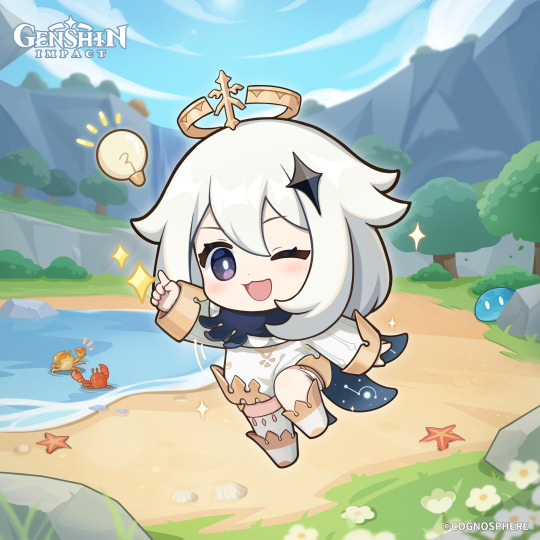
Genshin Impact 2023 Birthday Artworks & Birthday Character Shorts: Paimon
Download (main art): Google Drive
#genshin impact#character artworks#Birthday Artworks#birthday shorts#2023 birthday shorts#Paimon#Aranara#Arama#Aradasa#Slimes
117 notes
·
View notes
Text
Okay so i was looking into the names of the characters for murder drones and I am going insane
Thad: comes from english and aramaic, means heart, representative of how hes kinda just a nice guy
Lizzie: name means gods promise, not sure if it represents anything
Khan: name means prince, representative of how he seems to be one of the main authorities in the bunker
Nori: has some weird ocean symbolism that doesn't really fit her, but also means "love" "my light" "my fire" and "world"
Uzi: Hebrew name for power and strength, representative of her strong will and raw power with the solver
Yeva: means life, was one of the only members of cabin fever to survive, and to recieve the patch making her immune to the solvers control.
Doll: means gift of god, representative of how she has control over the absolute solver, the powers of a god. also ties to russian nesting dolls, as well as her button eye patch giving her a doll-like appearence.
Tessa James Elliot: Tessa meanings are harvester or reaper, indicitave of how she claimed to want to kill all of the infected drones, as well as the fact that she wanted to in reality destroy everything, as well as the fact that she was harvested herself by cyn. James means "supplanter" or "Assailant", indicitave of how she was replaced by cyn, and now is assailing the characters. Elliot means "The Lord is My God", which, similar to the other religious names, seems to refer to the absolute solver, and how she is, in reality, a servant of the solver of the absolute fabric.
N: okay tbh its difficult to find information on letter symbolism and some of the sources I found semed pretty sketchy, but from what I found the letter n means creativity or spiritual growth. idk if this is even true though
V: same disclaimer as with N, but I think it symbolises defiance of authority or that a situation is out of your control, which fits with her refusal of cyn, while also giving in to senseless violence as she felt that there was nothing else she could do
J: again, no clue if true, but, from what I found, the letter j symbolises justice and rules, which checks out with her extreme devotion to those in power and doing what she is told.
#murder drones#doll murder drones#murder drones doll#murder drones tessa#murder drones thad#murder drones lizzy#murder drones khan#murder drones nori#khan doorman#nori doorman#murder drones uzi#uzi doorman#murder drones yeva#murder drones n#serial designation n#murder drones v#serial designation v murder drones#murder drones j#serial designation j#v murder drones#v md#n murder drones#n md
58 notes
·
View notes
Note
Dogman, I have come to show you my collection of Dave's lines in progress
As of right now I have dsaf 1 gnarly, dsaf 2 legacy/fairly evil and the true good ending and I working on dsaf 3 good ending
Aren't you proud if me, papa?

I'll say, the dedication's impressive. In fact, manually transcribing this much of a character's dialogue from a meme game series is kind of like the 21st century equivalent of being a 15th century monk and transcribing entire manuscripts worth of deep theological scribings by hand, using an ink and a quill. I have to assume that when you finish, you'll be basked in light and float into the air, chanting in Latin or perhaps Aramaic. Untold power shall be yours. Probably.
152 notes
·
View notes
Text
Ranking my favourite natural writing systems by sexual appeal
1. Burmese: မြန်မာအက္ခရာ
2. Tibetan: བོད་སྐད
3. Mkhedruli (Georgian): მხედრული
4. Baybayin (Tagalog): ᜊᜌ᜔ᜊᜌᜒᜈ᜔
5. Devanagari (Sanskrit and Hindi): देवनागरी
6. Hebrew: אָלֶף־בֵּית עִבְרִי
7. Arabic: كتابة عربية
8. Javanese: ꦧꦱꦗꦮ
9. Thai: ภาษาไทย
10. Bengali: বর্ণমালা
11. Sinhalese (Sri Lankan): සිංහල (yes this is the language with the ඞ character)
12. Greek: ελληνικά
13. Katakana (Japanese): カタカナ
14. Hangeul (Korean): 한글
15. Hiragana (Japanese): ひらがな
16. Amharic (Ethiopian): ኢትዮጵያ
17. Kanji (Japanese): 漢字
18. Syriac (Aramaic): ܫܢܐ ܣܘܪܝܝܐ
19. Akkadian: 𒀝𒅗𒁺𒌑
20. Mandarin (Sorry, it’s the only Chinese language I’m semi-familiar with, I’m basic): 官话
21. Cyrillic (Slavic): кириллица
I LIKE ALL OF THESE, I JUST LIKE SOME EVEN MORE THAN OTHERS
#linguistics#writing systems#burmese#tibetan#georgian#baybayin#devanagari#sanskrit#hindi#hebrew#arabic#javanese#thai#bengali#Hebrew and Burmese are the ones I’d write English in
36 notes
·
View notes